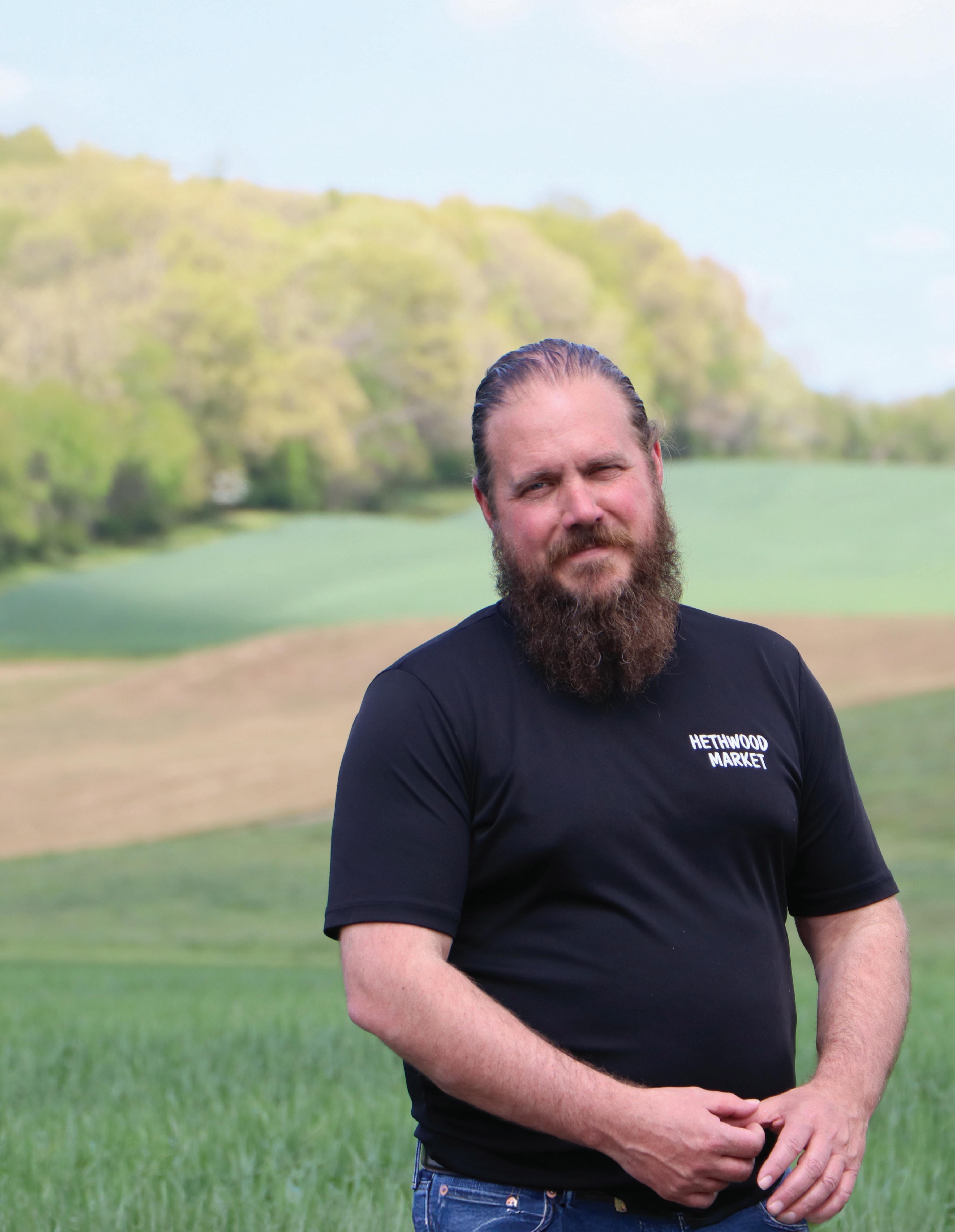











President Scott Sink plans to lead VFBF forward

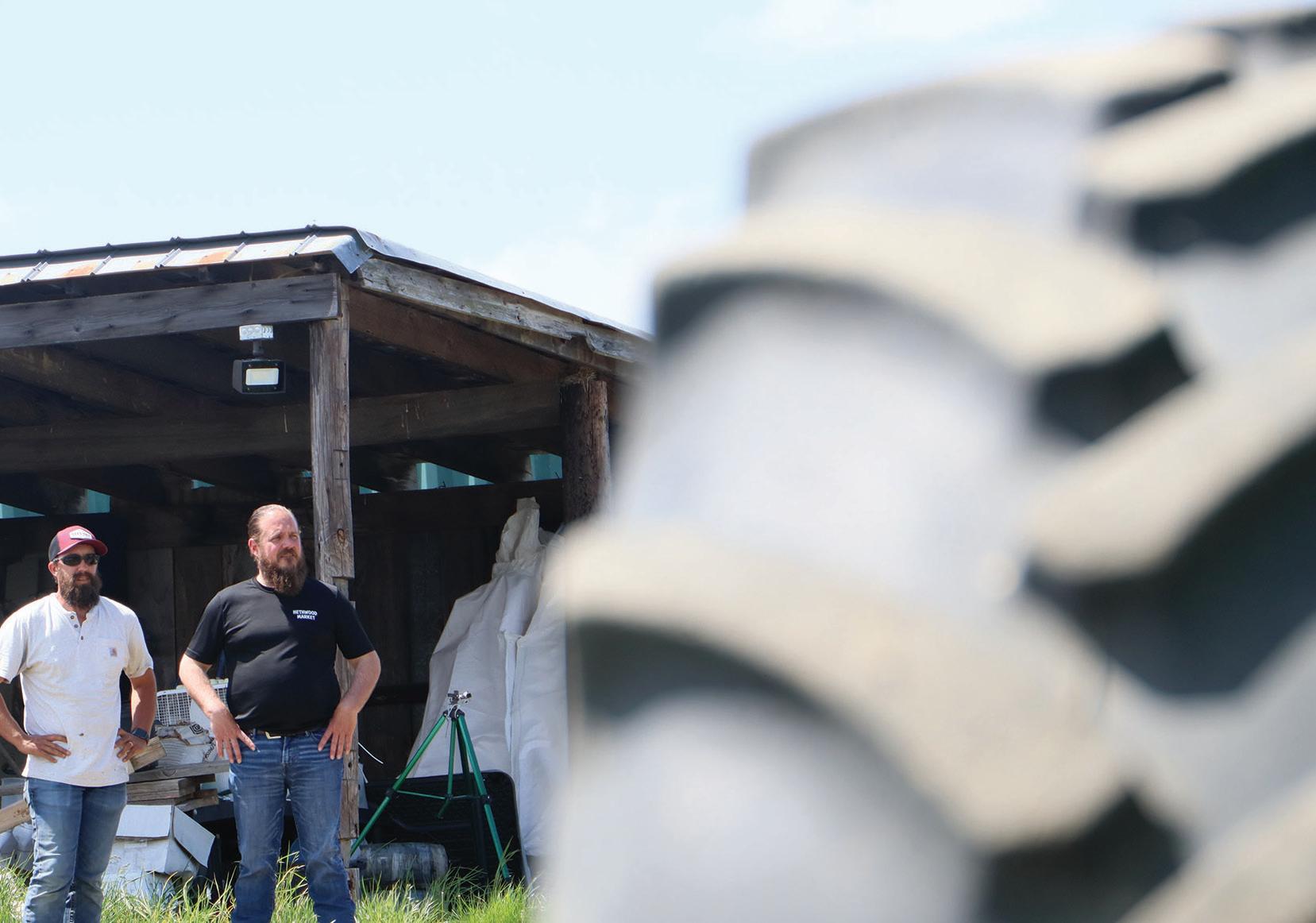

Farm Bureau News
Volume 84, Number 2 April 2025
Virginia Farm Bureau News (USPS 017-763) (ISSN 1525-528X) is published four times a year. January, April, September, November. It is published by Virginia Farm Bureau Federation, 12580 West Creek Parkway, Richmond, VA 23238. Periodicals postage rate is paid at Richmond, VA and additional mailing offices. The annual Subscription Rate is $1.13 (included in membership dues).
Postmaster: Please send changes of address to, Virginia Farm Bureau Federation, Farm Bureau News, P.O. Box 27552, Richmond, VA 23261-7552; fax 804-290-1096. Editorial and business offices are located at 12580 West Creek Parkway, Richmond, VA 23238. Telephone 804-290-1000, fax 804-290-1096. Email virginiafarmbureaunews@vafb.com. Office hours are 8 a.m. to 4:30 p.m., Monday through Friday.



Virginia farmers joined thousands of others to vote on national





A February snowstorm resulted in the 2025 VFBF Young Farmers Winter Expo being held virtually.




Newly elected President Scott Sink plans to face challenges, build collaboration and lead Farm Bureau into its next 100 years of success.





“What technology is allowing us to do is exciting.”
— SCOTT SINK, VFBF president
Members — Address change? If your address or phone number has changed, or is about to change, contact your county Farm Bureau. They will update your membership and subscription information. All advertising is accepted subject to the publisher’s approval. Advertisers must assume liability for the content of their advertising. The publisher assumes no liability for products or services advertised. The publisher maintains the right to cancel advertising for nonpayment or reader complaints about services or products.
Member: Virginia Press Association
EDITORIAL TEAM
Pam Wiley Vice President, Communications
Kathy Dixon Managing Editor
Nicole Zema Sr. Staff Writer/Photographer
Christina Amano Dolan Staff Writer/ Photographer
Kenny Kane Graphic Design Manager
Eleanor Stickley Sr. Graphic Designer
Alice Kemp Sr. Staff Writer/Advertising Coordinator
VIRGINIA FARM BUREAU FEDERATION Officers

The Virginia Farm Relief Fund collected $278,000 to help Southwest Virginia farmers affected by Hurricane Helene; other farmers stepped up to help.


Farm

it comes to


and some are coming up with
Producer members will receive their next issue of Virginia Farm Bureau News in September. The magazine is published quarterly, and back issues can be viewed at issuu.com/ virginiafarmbureau
WE’RE SOCIAL!
Scott E. Sink, President
Robert J. Mills Jr., Vice President
Board of Directors
DIRECTOR DISTRICT COUNTY
Emily F. Edmondson 1 Tazewell
Richard L. Sutherland 2 Grayson
Bruce N. Stanger 3 Montgomery
Jeannie L. Dudding 4 Craig
Russell L. Williams II 5 Rockbridge
Justin Pence 6 Shenandoah
Thomas E. Graves 7 Orange
Leigh H. Pemberton 8 Hanover
William F. Osl Jr. 9 Cumberland
A. Bruce Slagle 10 Halifax
Matt T. Fimon 11 Brunswick
J. Barry Bates 12 Essex
Gary D. Cross 13 Southampton
David L. Hickman 14 Accomack




A. Faye Hundley * Essex
Thomas N. Henley ** Goochland
*Women's Leadership Committee Chair
**Young Farmers Committee Chair

Just as plants require strong roots and rich soil to grow, Virginia Farm Bureau needs to build on its solid foundation to expand its future reach.
As we prepare to celebrate 100 years of VFB in February 2026, I’d like to share my vision for how we can position our organization for success in the next 100 years.
The four pillars of leadership, for me, are connection, and being proactive, purposeful and transparent
We need to work on connecting all consumers to agriculture. Many don’t understand how blessed Virginia is to have such an abundant scope of commodities throughout our diverse regions. Farm Bureau has always capitalized on that diversity, but we now need to be ready to embrace additional types and sizes of farms.
There also needs to be more connection and communication among county Farm Bureaus, our home office and all of Farm Bureau’s affiliated companies. It’s my goal to visit every county Farm Bureau to get your valuable input as to how we can better accomplish this.
Being proactive is a fundamental principle for me. Too often we have found ourselves being reactive, fighting regulations that have already been signed into law. We need to tackle difficult topics and partner with other groups in and outside of our industry to find positive solutions in advance, instead of playing defense.
Our grassroots process is part of that proactivity, but we need to take it a step further. At the county level, I’d like to see each county Farm Bureau create a business plan to set goals for future engagement and membership growth. Meetings should be intentional in purpose and not just held for the sake of tradition or having a meeting.
In terms of being purposeful, I’d like to leverage the experience of senior employees while simultaneously developing future leaders of the company. We’ve been fortunate to have a large number of tenured staff, but several of those positions will turn over in the next few years. It’s important to embrace the knowledge of our long-tenured employees while also implementing new ideas or finding more efficient ways of doing things.
I’d also like to see us be more transparent in facing Virginia’s agricultural challenges. The rollercoaster ride of commodity prices has always been an issue for farmers, but it seems like the fluctuations in the market are now more extreme and frequent. This makes it tough for farmers to make or follow a stable business plan. Farm transition and loss of infrastructure are two other challenges that should be discussed. We need to be open about the negatives and work together to find positive solutions.
My challenge to all of you, our producer members, is to make your voices heard. Contact me about your ideas for moving Farm Bureau forward by scanning the QR code, and together we will grow stronger.

Scott Sink, an agritourism operator and beef cattle and hay farmer in Franklin, Montgomery and Pulaski counties, is president of Virginia Farm Bureau Federation.
*As of March 14, 2025


The amount of money collected through the Virginia Farm Relief Fund, which provided assistance to almost 80 farmers adversely affected by Hurricane Helene. See related article on page 19.


Featured this month on Real Virginia, Virginia Farm Bureau’s weekly television program:
• Find out how Farm Bureau members are working with state legislators to convince Congress to pass an updated farm bill.
• Learn how Virginia-raised merino sheep become the fiber for some beloved garments.
• Discover the variety of agricultural pursuits in King George County, where 96% of its farming focuses on growing hay, grains and vegetables.
Real Virginia airs nationwide at 5 p.m. on the first and third Saturdays of each month in the Voices of Agriculture program on RFD-TV on Dish Network and DirecTV; and on selected cable outlets around the state. It airs weekly on WBRA digital channel 15.2, the WHRO World Channel, WVVA Bluefield and WTKR Norfolk, and on the first and third Sundays of each month at 10 a.m. on WVIR Charlottesville and at 10:30 a.m. on WHSV Harrisonburg; and on the first and third Saturdays at 8 a.m. on WRLH Richmond and at 5:30 a.m. on WSLS Roanoke.
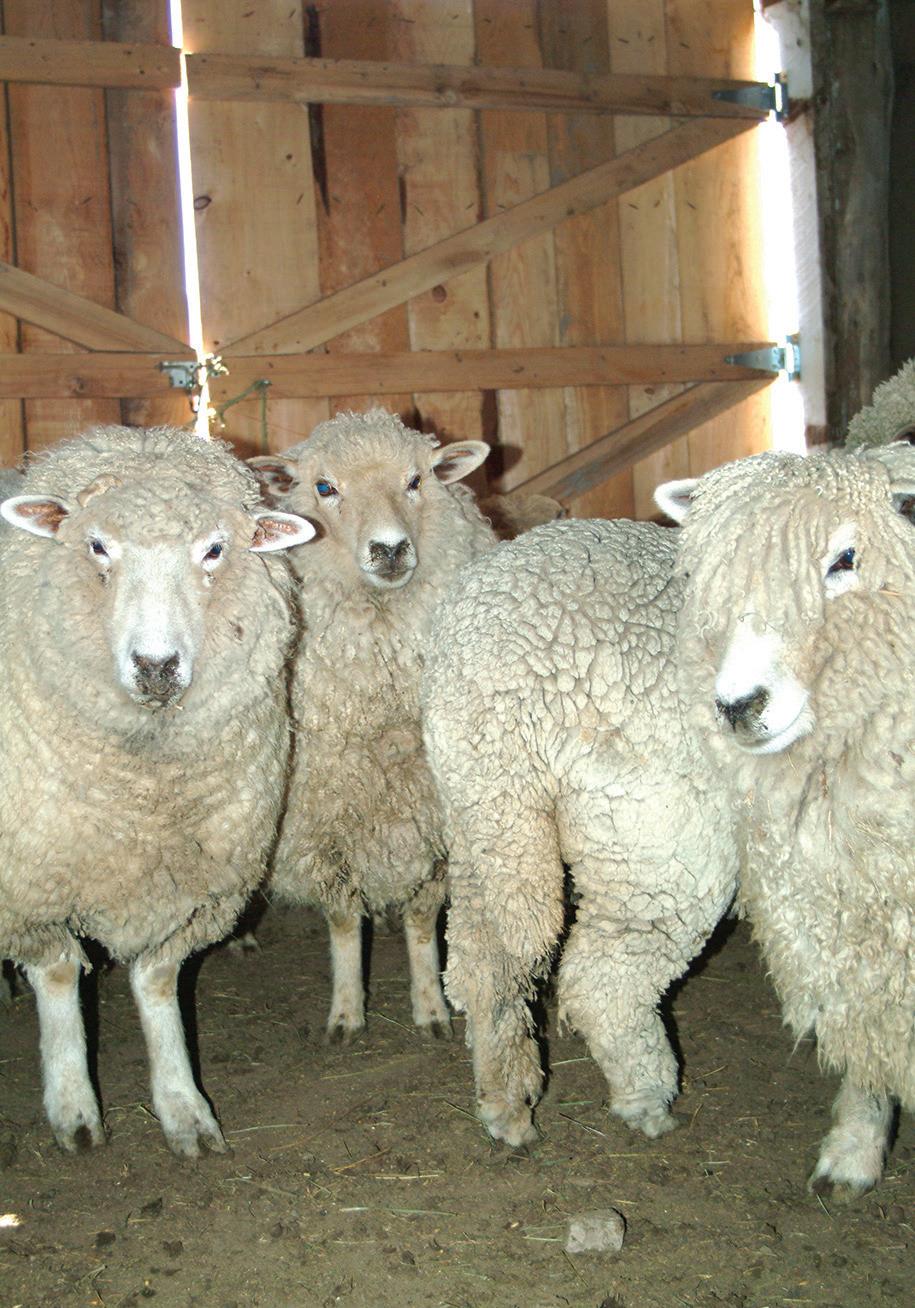
Sponsors and teams of four are invited to tee off in the 28th annual Virginia Foundation for Agriculture in the Classroom Charity Golf Tournament in May. The tournament will offer two shotgun starts with awards following each round of play. Food and refreshments will be available throughout the day.
• When: May 5
• Where: The Dominion Club in Glen Allen
• Registration: Visit virginia.agclassroom.org/donors/events for details and registration.

Annual Convention to be held in Williamsburg
The 2025 Virginia Farm Bureau® Federation Annual Convention will be held Dec. 1-4 at the Williamsburg Lodge. Plans for the annual event include guest speakers, policy discussion, competitive events, award recognitions and informative programming.
Registration is expected to open by Labor Day. The convention is open to county Farm Bureau members, staff and any member of the public interested in learning more about Virginia agriculture.


As of April 1, there are exactly 178 days until the 2025 State Fair of Virginia opens on Sept. 26. Showcasing all the excitement to be found at the state fair, this year’s theme is “Real Fun, Real Virginia.”
Fair fact:
The 2024 fair hosted more than 4,500 exhibitors and drew nearly 10,000 entries in competitions for livestock, vocational and technical education, visual and culinary arts, horticulture and more. Additionally, since 2013, the State Fair of Virginia has awarded over $1 million in scholarships to support youth education.
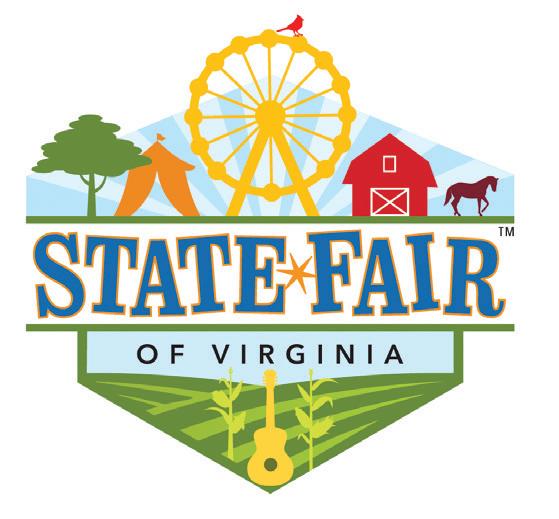
If you’d like to earn blue ribbon bragging rights in the fair’s competitions this fall, now is the perfect time to brainstorm and practice what you’d like to bake, cook, craft, grow or raise! The fair’s 2025 competition guidelines will be available this summer at StateFairVa.org.

The 2025 Virginia Conference on Agricultural Trade will be held April 22 at the Richmond Marriott Hotel in downtown Richmond. The agenda and details were still being developed at press time.
The Virginia Farm Bureau Farm Safety Program has started a new initiative—Safety Awareness for Farm Equipment on Roadways, or SAFER
The initiative kicked off with a contest to raise awareness of slowmoving and large farm equipment on the roadways, and the potential dangers involved in transporting them.
Farmers, community groups and civic and youth organizations are invited to create visual displays depicting the size difference between farm equipment and regular vehicles. The goal is to have displays in high-traffic public areas that will help make drivers more aware of farm equipment on the roadways.
There also is a category for educational campaigns that don’t involve a physical display, and a category for the most effective use of media channels to educate drivers about the presence of farm equipment on roadways.
The contest runs through Oct. 31, and winners will be eligible for thousands of dollars in cash prizes.
For details, visit vafb.com/Safety




















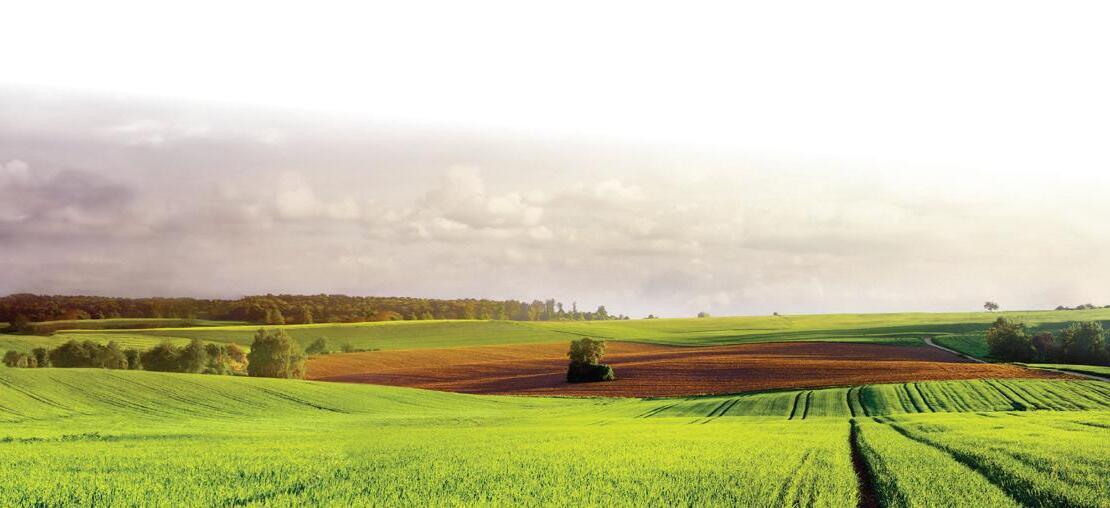







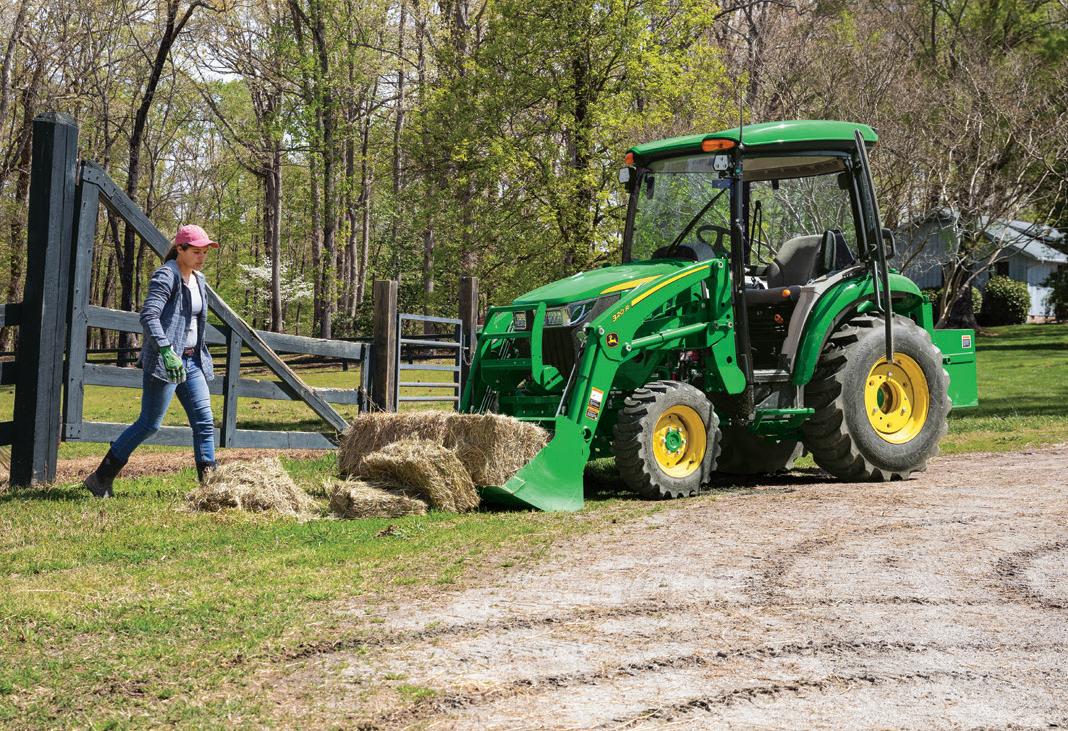
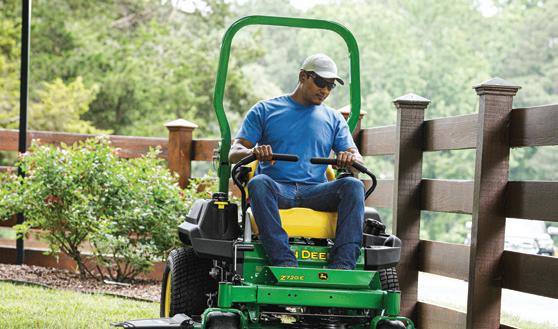

Save up to 30% off Avis base rates with Virginia Farm Bureau’s Avis Worldwide Discount number. In addition, enjoy additional offers like dollars off, a complimentary upgrade or a free weekend day.
Call 800-331-1212 or visit avis.com/vafb to make a reservation.
Save up to 35% off Budget base rates with Virginia Farm Bureau’s Budget Customer Discount number. Plus get other great offers like dollars off, a free upgrade or a free weekend day. Call 800-527-0700 or visit budget.com/vafb to make a reservation.
Your Virginia Farm Bureau Avis Worldwide Discount number and Budget Customer Discount numbers are available from your county Farm Bureau and in the “Membership at Work” section of vafb.com (Register as a member on the site, and log in first).
Your Farm Bureau membership entitles you to significant savings at thousands of hotel properties. Reservations are required, and blackout dates may apply.
The Choice Hotels International program offers a 20% discount off “best available rates” for Farm Bureau members at more than 7,000 locations. To access this discount rate, visit choicehotels.com or go to vafb.com/ benefits and log in with your membership number.
Located in Pigeon Forge, Tennessee, Dollywood is recognized as one of the world’s best theme parks. Spanning 150 acres and located near Great Smoky Mountains National Park, Dollywood offers more than 40 rides and attractions, including Lightning Rod, the world’s fastest wooden coaster. Dollywood has won more awards than any other theme park for its live shows featuring country, bluegrass, Southern gospel and classic rock. Master craftsmen demonstrate the area’s rich artistry, from hand-blown glass to blacksmithing. Members may purchase discount tickets to the Dollywood Theme Park by visiting vafb.com/benefits or Dollywood.com.
Member Deals Plus® uses the nation’s largest private discount network to save you money on meals, clothing, vehicle care and other goods and services. It uses “show your phone” mobile deals that can be accessed anywhere and redeemed from a smartphone at the point of sale, or from a home computer.
• To register as a new user, visit vafb.com/benefits.
• To save with a mobile device, download the “Member Deals Plus” app from the AppStore or Google Play.
Members can enjoy discounts on amusement parks, apparel, dining, gifts, movies, museums and more! For assistance, call Member Deals Plus customer service, 888-275-9136.
*Member Deals plus and Member Deals Plus are registered trademarks of Virginia Farm Bureau Federation.


‘It

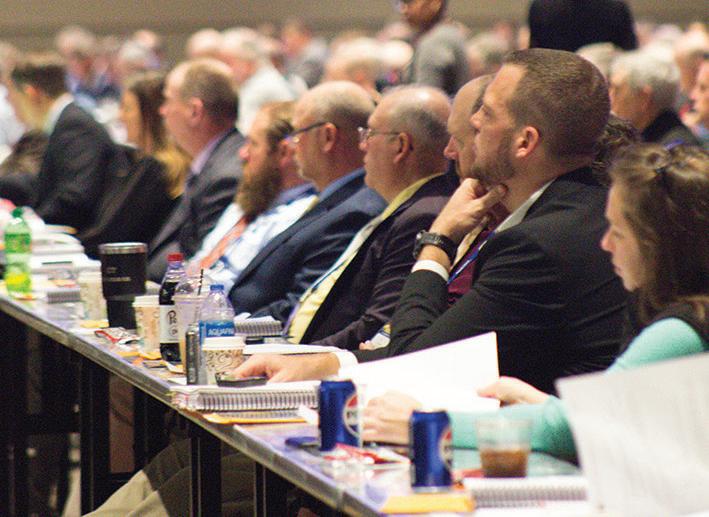
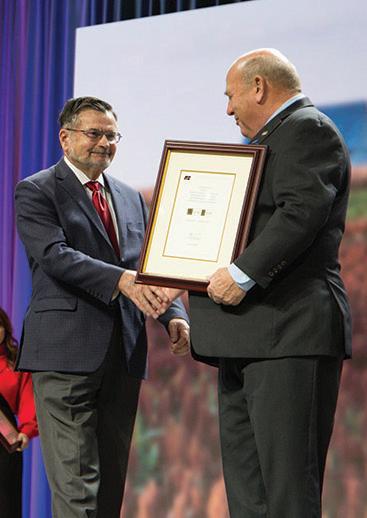

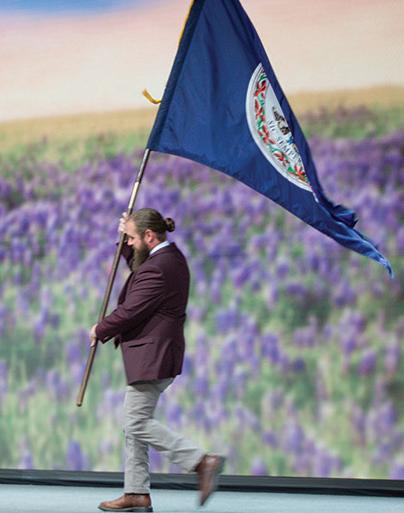
ARTICLE AND PHOTOS BY CHRISTINA AMANO DOLAN
Virginia agricultural leaders answered the call to “step up and drive forward” in January as part of the 106th annual American Farm Bureau Federation Convention in San Antonio.
Uniting with over 5,000 farmers and ranchers from across the country, Virginia Farm Bureau Federation delegates voted on national policy. Farm Bureau members also attended workshops and cheered on VFBF Young Farmers competitors.
Applauding attendees’ commitments to their farms and communities, AFBF President Zippy Duvall said driving agriculture forward takes all of us.
“Our voices have never been more important than they are today,” Duvall told producers. “Let’s help America understand all the ways we’ve moved agriculture forward, all the tools that we need to continue the success, and our commitment above all to provide safe, healthy, affordable food for our country.”
Grassroots leaders received the convention spotlight and enjoyed a special reception as part of the organization’s “Year of the County Farm Bureau President.”
“Having an impact—making a real difference—begins with you, at the local level,” Duvall told county leaders.
“Whether you’re giving back to your communities or helping farmers pick up the pieces from a storm, you are the heartbeat of the federation.”
He applauded landmark achievements made possible by engaged grassroots members, including sending a record 50,000 messages to Congress and federal agencies last year.
VFBF county presidents in attendance included Thomas Byrne, Rockingham County; Jamie Corl, Sussex County; Gary Cross, Southampton County; Chuck French, Shenandoah County; Faye Hundley, Essex County; Amy Johnson, Bedford County; Leigh Pemberton, Hanover County; Mack Smith, Rockbridge County; and CT Thiemann, Louisa County.
VFBF Young Farmers take center stage

Augusta County young farmer
Morgan Slaven claimed second place in the AFBF Excellence in Agriculture Award competition. In a live presentation to judges, she showcased her background, contributions, barriers and triumphs in agriculture.
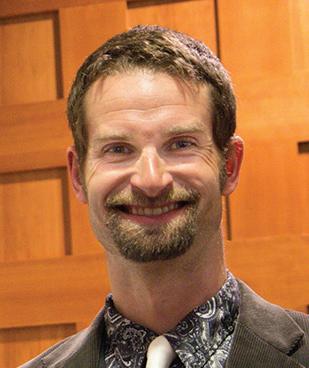
VFBF Women’s Leadership Committee members attended their annual meeting, the AFBF Women’s Leadership Southern Region meeting and a variety of workshops.
Additionally, committee members, along with Duvall and VFBF President Scott Sink, helped pack 3,000 nutritious meals for donation to local food banks and shelters.
Duvall lauded women’s leadership committee members as “key decision makers in agriculture and Farm Bureau.”
other. It really gets your feet wet with what Farm Bureau is all about.”
Committee members who offered input on policy also included Katelyn Burner of Orange County; Michelle Martin, Augusta County; Candace Monahan, Botetourt County; Cecilia Moyer, Ameila County; Carolyn Neal, Tazewell County; Jamie Pence, Shenandoah County; and Ann Smith, Rockbridge County.
Marshall Slaven, an Augusta County cattleman and Morgan’s brother, participated in the national Discussion Meet. During the roundtable discussions, he talked about succession planning, diversifying farm portfolios and ways Farm Bureau can support young farmers.
Faye Hundley, chair of the VFBF Women’s Leadership Committee, said it’s exciting to collaborate and network with agricultural leaders from across the country.
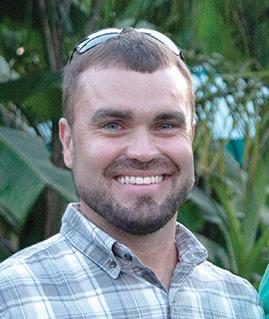
Bradley Ragsdale, a Pittsylvania County farmer and VFBF Achievement Award recipient, also competed on the national level.

Ashley Kuhler of Shenandoah County represented Virginia on a “Youth to Farm Bureau Pipeline” panel, and offered advice to aspiring agricultural leaders.
“It’s just a great involvement,” she reflected. “You’re talking about agriculture with like-minded people and gleaning great ideas from each
Sink was elected to fill a one-year term representing the Southern region on the AFBF board of directors—a position previously held by former VFBF President Wayne F. Pryor.
Sink also led a group of eight voting delegates from Virginia who helped shape national agriculture advocacy efforts for 2025.
“Seeing the efforts of VFB staff and our producer member volunteers was


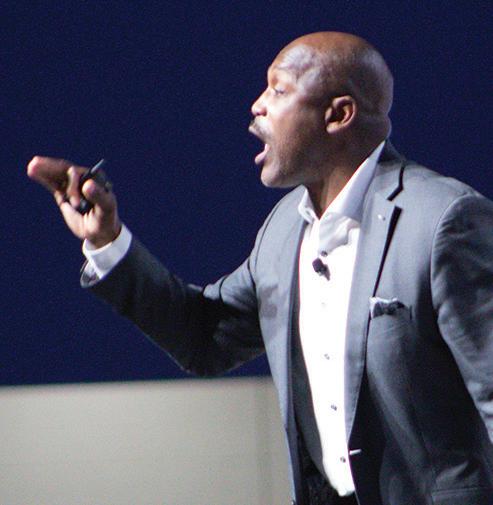
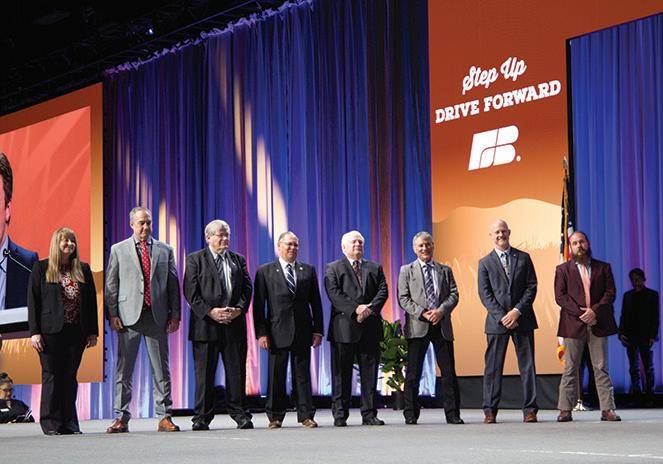


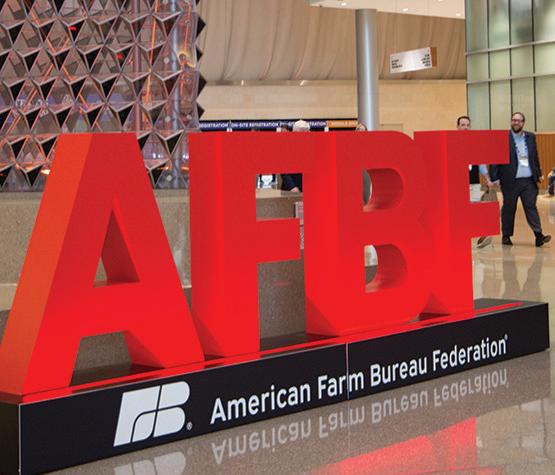

a rewarding experience,” he said. “I appreciate the commitment of our young farmers competing, as well as our women’s delegates and voting delegates representing Virginia in the policy development process.”
Virginia delegates successfully introduced policies or amendments to:
• Support maintaining the current structure of the U.S. Department of Agriculture Noninsured Crop Disaster Assistance Program for hay and forage production in the farm bill.
• Include an option to have a six-month pre-approval for a Farm Service Agency loan, with an extension in the event of any project delays resulting from government permitting or review.
• Support requiring each government regulatory agency to establish guaranteed 30-, 60- or 90-day response and completion timelines for each type of environmental review.
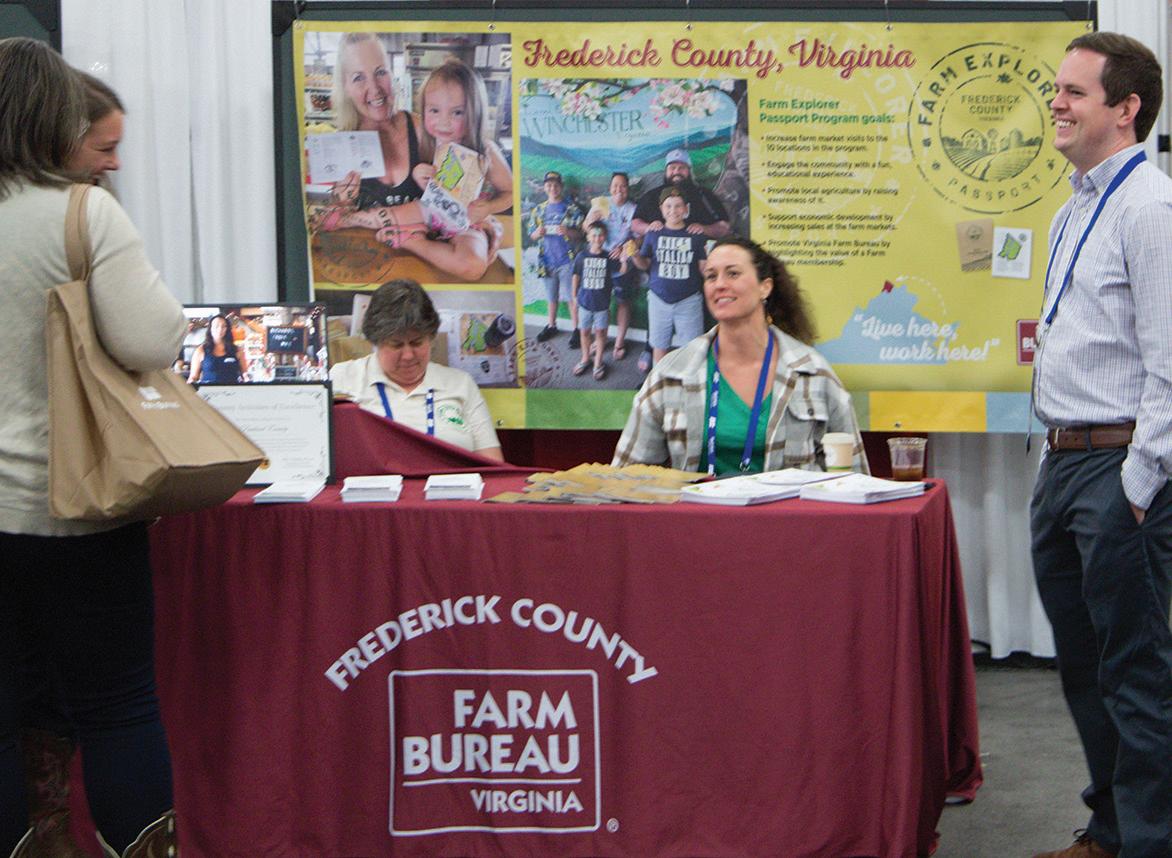
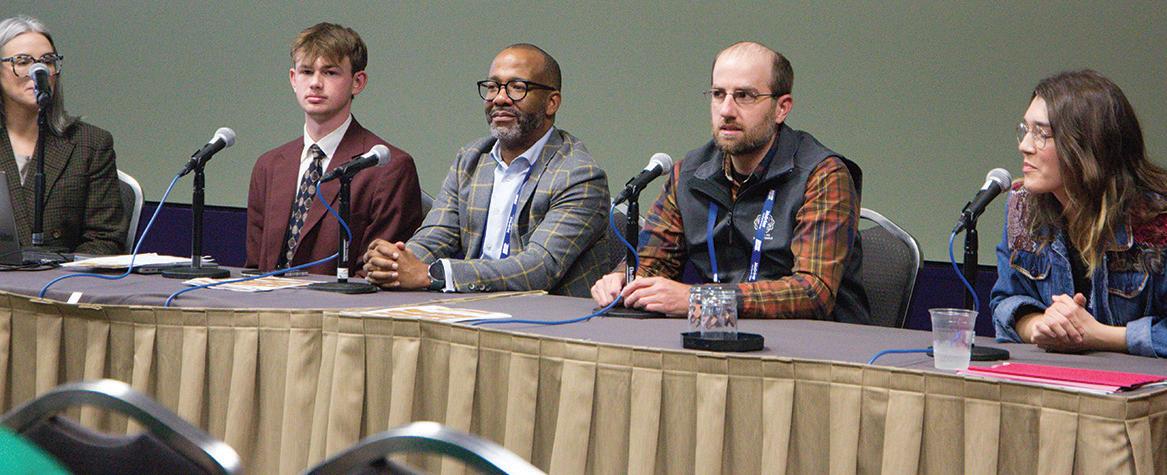
Delegates from Virginia included
VFBF Vice President Robert Mills Jr.; and county leaders James Corl of Sussex; Kory Gough, Prince William/ Fairfax; Amy Johnson, Bedford; Cindy Lam, Page; Hunter Richardson, King & Queen; and CT Thiemann, Louisa.
A farm bill workshop reminded farmers of the vitalness of their voices amid federal budget reconciliation, a wave of newcomers to Congress and other obstacles slowing progress on passage of a modernized farm bill in 2025.
At a livestock markets workshop, farmers learned that demand and price for beef and most poultry products are strong. However, ongoing avian influenza outbreaks, contraction in the cattle industry, higher interest rates and inflation-driven input costs present challenges and uncertainty.
Virginia received AFBF Awards of Excellence in all four program areas: advocacy; coalitions and partnerships; engagement and outreach; and leadership and business development.
Frederick County Farm Bureau was among 24 county Farm Bureaus to receive an AFBF County Activities of Excellence Award and was featured in the trade show. The awards celebrate unique, volunteer-driven programming at the local level.
Frederick County Farm Bureau was recognized for innovative efforts to connect consumers to the farm. The organization’s Women’s Leadership Committee developed the “Farm Explorer Passport Program” to boost traffic to area farm markets and promote agriculture in the county.









For nearly a century, Virginia Farm Bureau has taken pride in being the collective voice for farmers.
Farm Bureau producer members determine the organization’s positions on all issues and are critically important in building relationships with both urban and rural legislators on those topics.
The following is a recap of key legislative issues impacting Virginia Farm Bureau Federation policy. Farm Bureau policy prevailed on 30 out of 49 issues. As a reminder, the outcome
of all legislation is not final until it is acted upon by Gov. Glenn Youngkin and reviewed by the General Assembly on April 2.
Here is how 11 key Farm Bureau policy positions fared during the 2025 General Assembly.
means Farm Bureau policy prevailed
means Farm Bureau policy did not prevail
Maintained full funding for ag BMPs as well as obtained an initial deposit of funding for the next two years of the budget.
Created greater flexibility in allowing the distribution of unallocated funds by Soil and Water Conservation Districts both in and out of the same watershed.
Established and funded a Large Animal Veterinary Grant Program to provide grants to increase or stabilize the number of large animal veterinarians in the commonwealth.
Prevented the imposition of advanced notification requirements for private and commercial pesticide applicators.
Decreased the pressure imposed by solar development on farm and forest lands by protecting local government authority on the siting of utility-scale solar facilities.
Alleviated the pressure imposed by solar development on farm and forest lands by granting local governments the authority to require installations of solar canopies over certain parking lots
Empowered localities to consider the impacts of a “high energy use facility” (data center) on natural resources such as water, agriculture, parks, registered historic sites or forestland.
Mandated consumer education about dangers of invasive species by requiring signage at retail establishments of over 35 invasive species.
Increased the current minimum wage rates and regulations and eliminated the longstanding farmworker exemption.
• This may change after the publication date, as Gov. Youngkin vetoed similar bills last year.
Stopped the labeling of food products as meat products made in a laboratory.
Maintained interbasin transfer of water where water can be withdrawn and transferred from one river basin to another.
Although this year’s General Assembly session has ended, Farm Bureau’s work is never done. The organization is working to have staff or members appointed to boards and various technical advisory committees or participate in meetings to ensure the proper implementation of current legislation. Additionally, members already have begun participating in
this spring’s regional policy development meetings to begin determining Farm Bureau’s policy positions for 2026.
If you are a producer member and do not receive Action Alerts but would like to, contact Tenille Nuckols, VFBF social media and member engagement coordinator, at tenille.nuckols@vafb.com or 804-290-1293


ARTICLE AND PHOTOS BY NICOLE ZEMA
Over 130 farm leaders representing 57 counties shared their perspectives on seven key agriculture issues in one busy morning at Virginia’s General Assembly on Feb. 3.
As part of Virginia Farm Bureau Federation’s annual Legislative Day, farmers met with lawmakers and aides to urge action on legislation favorable to agriculture and forestry. Advocates expressed support or concern for bills regarding local zoning authority for utility-scale solar facility siting, farm labor, the large-animal veterinarian shortage and retail labeling of invasive plant species.
VFBF’s governmental relations staff said more meetings were booked with legislators and aides than ever before. Working lands and state advocacy specialist Rachel Henley said staff also has focused on building relationships with urban legislators over the last decade.
“We are working to increase outreach
to legislators who do not have our members as constituents,” she said. “Their work may be impacting votes, which is particularly important when the rural or Republican legislators do not have the majority in either body. Our members said they had good visits with them.”
A Feb. 2 dinner featured remarks from Sen. Dave Marsden, D-Burke, chair of the Senate Agriculture, Conservation and Natural Resources Committee. He was lauded for
sponsoring many of Farm Bureau’s budget amendments in the past.
Marsden acknowledged that change is felt more acutely in rural Virginia compared to urban areas.
“You’re now dealing with issues foisted upon you by people who may not understand what you’re going through,” he said to the farm advocates.
That’s why legislative advocacy is worthwhile, Marsden added.
“We need to understand what you
VFBF Senior Vice President of Governmental Relations Martha Moore and VFBF President Scott Sink,
share priority issues with Sen. Dave Marsden, D-Burke. Eastern Shore farmers talk to William Humphrey, legislative assistant for Sen. Bill DeSteph, R-Virginia Beach, about legislation affecting agriculture.
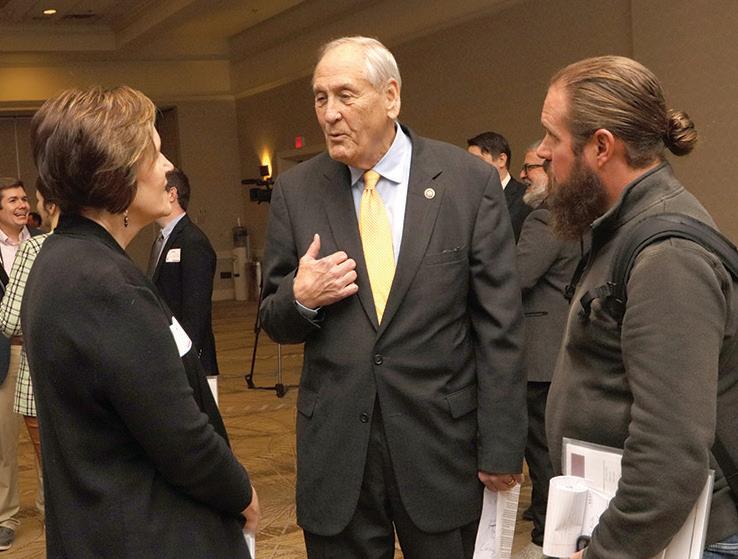


go through to provide us with the sustenance we need to survive in Virginia,” he said.
Over 2,300 bills were introduced in this abbreviated General Assembly session. Upward of 600 failed to advance, while 300-plus passed the House and Senate.
Farm Bureau opposes HB 2438, which narrowly passed the House 48-46. The bill raises concern that all Virginia localities may be required to adopt statewide standards for solar facilities on land zoned for agriculture. Over 600 Farm Bureau members responded in less than 24 hours to an Action Alert asking them to contact their legislators about the bill.
Meanwhile, advocates voiced support for related bills that aim to decrease the amount of open space consumed by solar, requesting solar panels be placed on previously developed sites including parking lots, buildings and brownfields.
Legislative Day first-timer Stacy Richardson of King and Queen County Farm Bureau Women’s Leadership Committee discussed energy issues with lawmakers representing the Upper Tidewater region.
“Sources of clean energy are needed, but also I care about the rights of landowners and local government,” she said to lawmakers. “I don’t think we should saturate our state with solar panels. However, there’s a place for them, and we need to find that balance!”
Eastern Shore farmers visited the office of Sen. Bill DeSteph, R-Virginia
Beach, and spoke with staff about bills to establish regulations regarding employee health and illness in highhazard industries.
“We feel that safety guidelines are already in place,” said Matt Hickman, Accomack County Farm Bureau president. “We do understand that sometimes bad actors push the limits of what people can do. But in standard practice, farm owners and other industries are looking to maintain the health of employees. This legislation seems like an overreach.”
His dad, VFBF state board member David Hickman, said workers accustomed to hot weather take personal precautions, in addition to being provided with water and shade.
“This is fixing a problem that doesn’t exist,” he said. “No one likes to work in 90-degree heat, but we do it all the time, and we certainly want our employees to be healthy. It’s the same with construction workers. They can’t stop working because it’s hot. Otherwise, nothing would get done!”
DeSteph’s aide said the senator planned to oppose that legislation.
A joint resolution was presented on the House floor to honor Wayne F. Pryor, who recently retired after 18 years as VFBF president, for his extensive service and contributions to Virginia’s agricultural community. He was recognized in the gallery with wife Pattie.
Snack bags loaded with Virginiagrown products also were distributed to legislators by Farm Bureau members.


Robert “Bobby” Goodwin was hired as a new District 9 field services director for the Membership & Field Service Department and member contact & engagement coordinator in the Communications Department.
In this role, Goodwin will serve Farm Bureau members in Amelia, Appomattox, Buckingham, Chesterfield, Cumberland, Nottoway, Powhatan and Prince Edward counties.
Goodwin previously worked as an agricultural sales representative for the Farm Bureau Products Division in mid-2024. He is a 2024 graduate of The Citadel, where he earned a bachelor’s degree in political science. He previously interned at Virginia Cooperative Extension’s Orange County office and with the Virginia Cattlemen’s Association, as well as with Wagonhammer Ranches in Nebraska.

BY CHRISTINA AMANO DOLAN
Winter storm warnings and hazardous road conditions across Virginia halted a weekend of networking, workshops and other in-person activities planned for the 2025 Virginia Farm Bureau Federation Young Farmers Winter Expo. The event would have been held Feb. 21-23 in Franklin County.
In light of safety concerns, the event transitioned to virtual programming via Zoom on Friday and Saturday. Over 40 attendees tuned in to workshops about VFBF Young Farmers committees and subcommittees; farm safety; cattle reproduction and genetics strategies; and farm transition planning.
Attendees also heard from VFBF President Scott Sink, who commended organizers for prioritizing safety.
“It was a hard decision, but with the weather damage we had last week and the incoming storm this week, it was definitely the right decision,” he remarked.
The 2025 Young Farmers Summer Expo will take place in Franklin County July 25-27.
Workshops emphasize readiness
Attendees of Friday’s safety workshop learned from Katie Hammock, an emergency room nurse and dairy farmer’s wife, about how to prevent tragedies on the farm.
According to Hammock, the top farm-related accidents involve medical emergencies and bleed, burn, crush and puncture injuries.
“Accidents are called accidents for a reason,” she warned. “I’ve seen people do everything right and still have a traumatic injury. You never know when something like this could happen to you or somebody you know.”
Hammock urged farmers to always keep a farm emergency kit at hand, with a tourniquet, a blood-clotting product, sterile bandage rolls, a CPR shield and a whistle. It’s also important to ensure someone is aware of your location and they should know how to direct emergency personnel to your fields.
She noted that those in the agriculture community are 3 ½
times more likely to die by suicide than the average population.
“If you or a loved one is suffering, you can go to an emergency department in any state and they will provide you with resources,” Hammock added.
Additionally, the AgriStress Helpline is available 24 hours a day, 7 days a week, and has interpretation services for 160 languages. Call or text 833-897-2474 to receive direct emotional support, advice and resources from a trained professional.
Farmers also learned the importance of preparation in achieving successful farm transitions during Saturday’s workshop led by Maggy Gregory, partner and co-owner of the law firm, Fisk & Gregory PLC.
She encouraged young farmers to first identify shared values and desires with older generations before discussing the business in depth.
“Don’t buy a used car without evaluating it first,” Gregory advised. “Everyone wants to look like they’re doing really well—they might have $1 million in equipment and be $1.2 million in debt.”
She recommended thoroughly reviewing tax records and financial statements; identifying any sources of off-farm income that are supporting business endeavors; keeping management and control separate from ownership; considering the needs of everyone involved; and assembling a team of professional advisers to assist with transition planning.
“Start having those conversations now. Keep on having them, so it’s not a surprise when it comes time for the next generation to move forward,” Gregory urged.
Saturday’s cattle reproduction and genetic strategies workshop covered how to unlock the full potential of beef and dairy herds. Sarah Morton of ABS Global provided practical insights into improving fertility; maximizing genetic progress; leveraging reproductive technologies for greater efficiency and profitability; selecting genetics that align with business goals; and optimizing breeding programs for long-term success.
‘ The next 100 years’
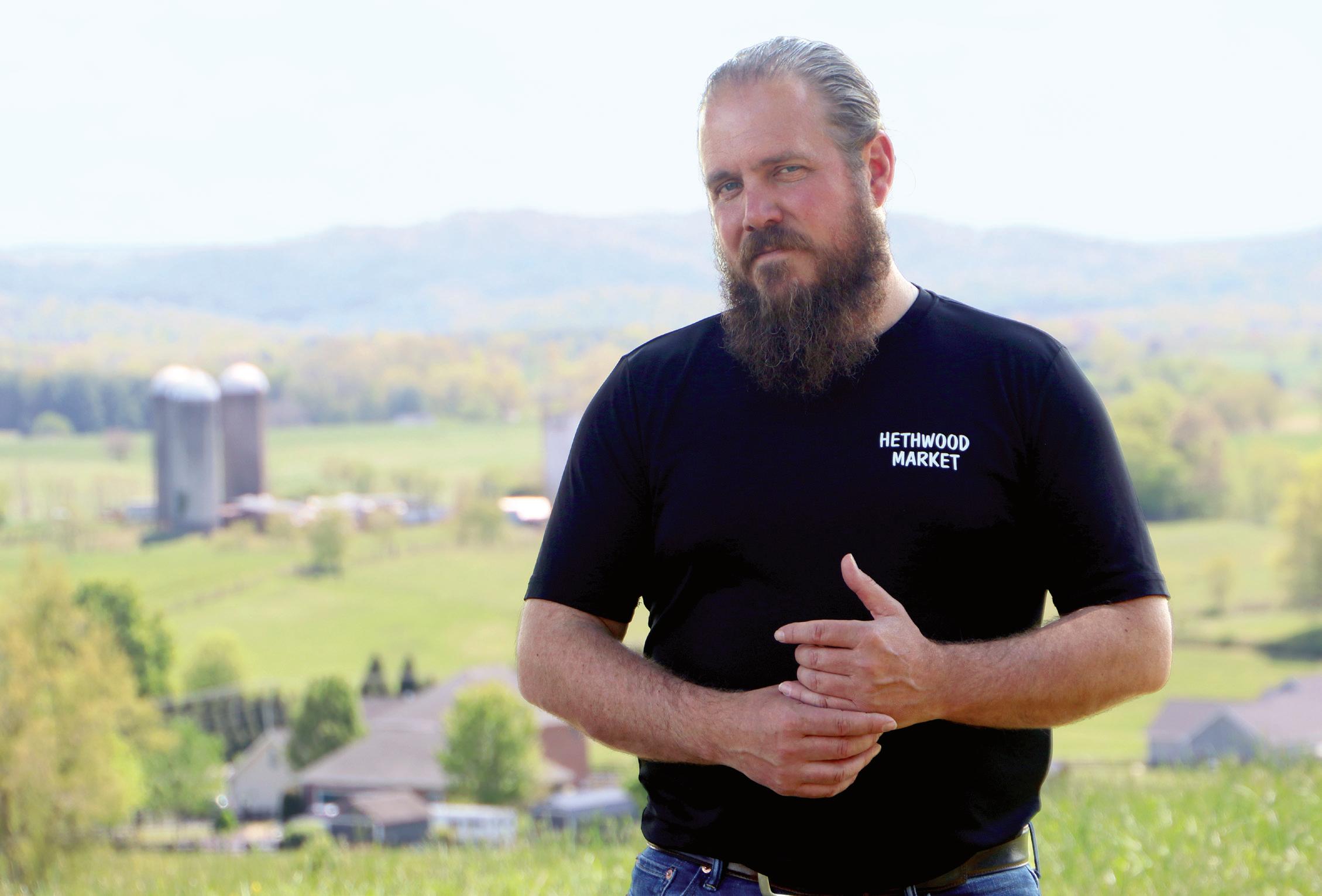
BY NICOLE ZEMA
Anew caretaker is cultivating the legacy sowed by past presidents of Virginia Farm Bureau Federation, while nurturing his own vision for the future of the state’s largest private industry.
In December 2024, Scott Sink was entrusted by VFBF voting delegates to lead the organization and its family of companies as president. On the cusp of VFBF’s centennial, he is looking ahead to the next 100 years.
He said the diverse scope of Virginia’s regions and commodities creates a host of opportunities to sustain and grow a robust agricultural economy.
“Farm Bureau has capitalized on that diversity over the past 100 years,” Sink observed. “Now we need to be ready to embrace even more diverse types of farms and opportunities.”
Sink joined the board of Franklin County Farm Bureau in 2000 and was one of the youngest producers in the state to serve as a county Farm Bureau president. He was elected to the VFBF board of directors as Young Farmers chair in 2007.
He was elected VFBF vice president in 2012 and began quietly serving and supporting Virginia’s farmers and the efforts of nowretired President Wayne Pryor.
Sink and his wife, Mendy, are familiar faces in Farm Bureau, along with their two daughters, Mekinsley, 17, and Mehailyn, 12, who have attended company events since birth.
“When Mendy returned to work from maternity leave, the girls went with me,” he said. “I took Mekinsley to a meeting in Raleigh
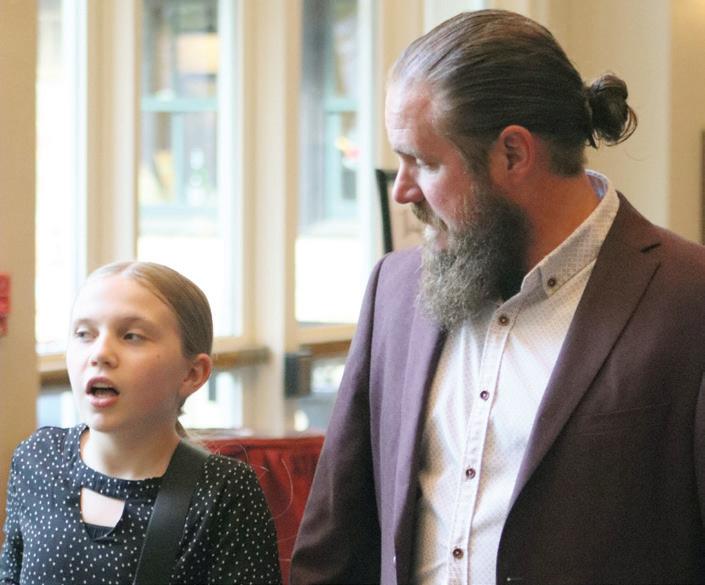
when she was just 8 weeks old!”
SES Agricultural Enterprises, the family’s farm operation, stretches through Franklin, Montgomery and Pulaski counties. They operate Riner Ridge Farm, which grows produce and greenhouse items to stock their Hethwood Market in Blacksburg.
They also raise beef cattle and hay, and manage a private event venue.
Facing challenges, seizing opportunities
While Sink’s partners, employees, family and friends help with daily operations, he keeps a watchful eye on goals and challenges for Virginia agriculture, like the rising costs of inputs and acreage.
“Some of that is tied to inflation, and some isn’t,” he said. “And another barrier to entry is the loss of our farm infrastructure.”
For example, the number of Virginia dairy operations has plummeted since his college days, taking peripheral sectors with it.
“You lose all the other services that supported it, which is a barrier to anyone who wants in,” Sink said. “Plus, the loss of access to resources and knowledge.”
The “rollercoaster ride of commodity prices” is an ongoing issue, he added.
“It seems like extremes are a more frequent occurrence, which makes it harder to plan for and anticipate opportunities,” Sink said.
And while ever-changing regulations are expected, “some regulations make no sense. We must be proactive in everything we do. Too often we are reactive, fighting regulations that already came out.”
As he works with farmers, company leaders, industry officials, lawmakers and staff to address these challenges, Sink is exploring opportunities for greater outreach, to educate Virginians disconnected from agriculture.
Those challenges coexist with optimism for the future of farming.
“What technology is allowing us to do is exciting,” Sink said. “Like robotic dairies, automation, drones, precision agriculture, and what artificial intelligence will bring to the table.”
Federation goals
Sink is invested in agriculture at the grassroots level as well. He is familiar with the trials of being “a new kid on
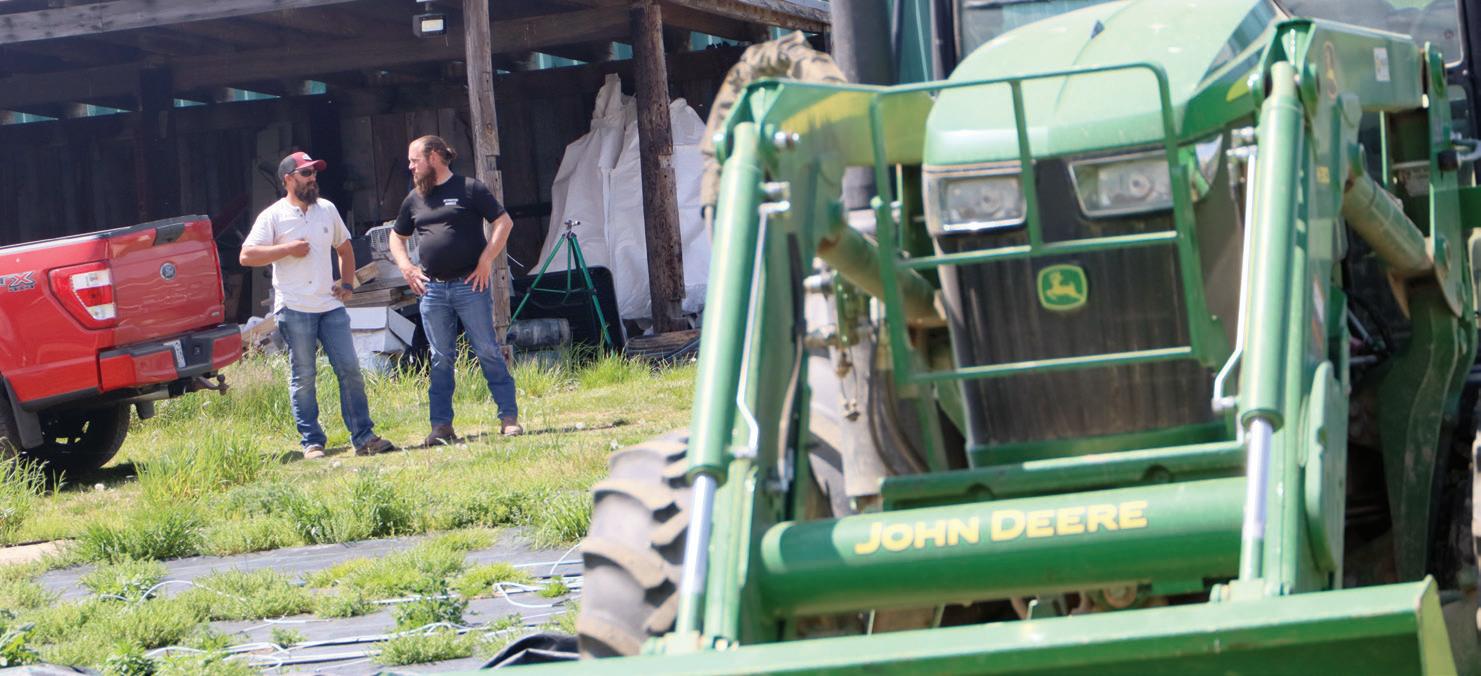
the block” as a beginning farmer.
“I had to make inroads to be accepted,” he recalled. “But our special programs like Young Farmers and the Women’s Leadership Committee give everyone a chance to share their struggles and successes.”
A focus on growing membership is among his Federation goals. While membership is driven by quota, Sink encourages county Farm Bureaus to focus on creating business plans that outline five-year goals and the financial provisions to reach them.
Sink wants to hear from members who have ideas for continued growth as he makes personal connections at all 88 county Farm Bureaus in the coming year.
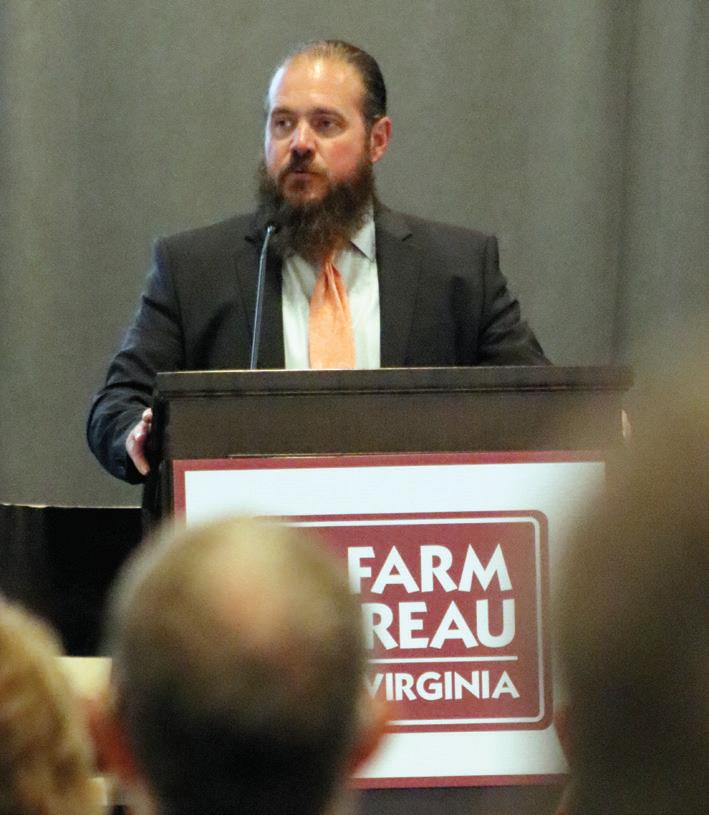
“Let me know how we make this better,” he said. “I will do something with that input.”
Sink has plans to strengthen connections and communications across the family of companies as well, through leveraging the experience of senior employees while developing future company leaders.
‘A different path’
As he adjusts to his new role, Sink is reflecting on the unexpected pathways and detours that led him here.
Though born to a multigenerational farm family in Franklin County, Sink considers himself a hybrid first-generation farmer. He started from scratch.
His grandparents encouraged him to pursue a career off the farm.
“I bought my first cow when I was 10,” Sink said. “My grandma was my loan officer that summer. She kept an envelope and made a tick mark for every $5 I earned. If it was a hot day, I got two tick marks. But that’s how I paid off my first cow, which became part of the dairy herd.”
Starting with that first cow, he has experienced the painful realities of farm life. His grandfather constantly reminded him of why he should choose a different path.
‘Funny how life works’
The first in his immediate family to earn a four-year college degree,
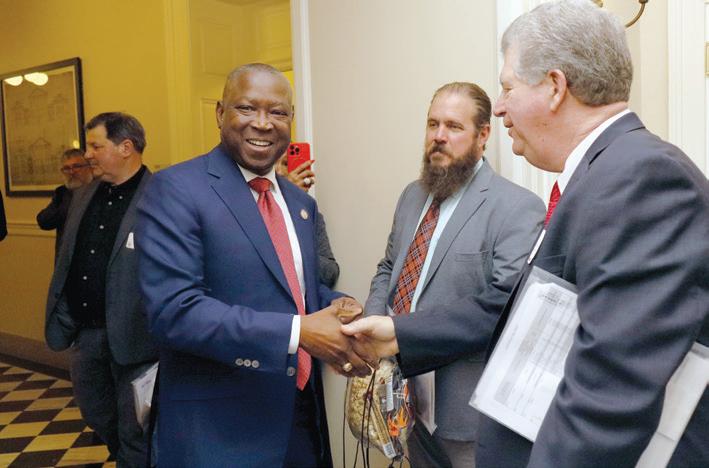
Sink originally planned to study business and law at the University of Virginia. While still in high school, he learned leadership skills through the Virginia Institute on Cooperative Education. His essay about the impact of cooperatives on rural and farming communities earned a national award.
At a subsequent speaking engagement, Sink met a professor of agricultural economics who insisted he consider Virginia Tech instead of UVA.
“It’s funny how life works,” he said. “You never know what crossroads will change your path in life.”
Sink’s path shifted again during a Governor’s Fellowship in the summer between undergrad and graduate school, when VFBF Young Farmers Committee member Hunter Richardson threw the 1999
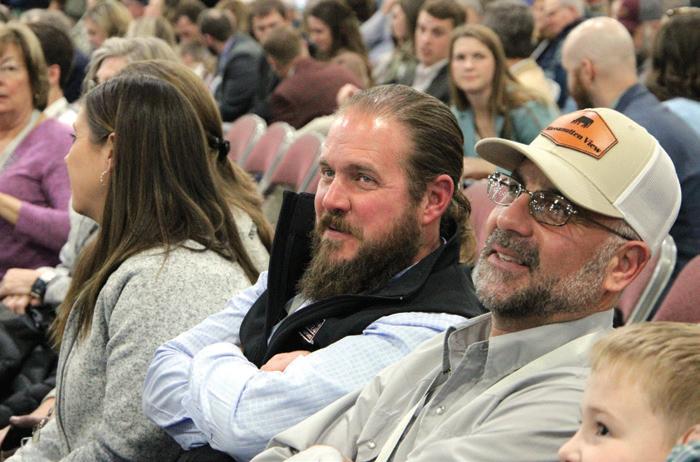
Discussion Meet study manual in his lap. The competition would be Sink’s first exposure to Farm Bureau.
“I’ve always recognized his competitive spirit, and his potential as a leader,” Richardson noted. “So, I told him to read up and participate in the next Discussion Meet. He was hooked, and the rest is history!”
Richardson was the VFBF voting delegate to nominate Sink for the presidency at December’s convention. He asked delegates and members who had personally worked with Sink to stand up.
“I was confident there would be a large number of people standing,” he said. “Scott has been trying to cultivate new leaders for many years, and the room was full of those young leaders he had touched.”

Clockwise from left, Sink met with representatives during the VFBF Legislative Day in January; he joined other Virginia members at the American Farm Bureau Annual Convention; Sink has helped cater Farm Bureau events; and he was part of the Virginia delegation that traveled to the General Assembly building on Legislative Day.

Elected VFBF president 2024
Served as VFBF vice president from 2012-2024
Served on AFBF Young Farmers & Ranchers Committee 2010-2012, elected vice chair 2011
AFBF Excellence in Agriculture Award winner 2010
Served as VFBF Young Farmers chair 2007-2008
Elected president of Franklin County Farm Bureau 2006
VFBF Young Farmers Committee 2003-2012

BY NICOLE ZEMA


While the losses accumulated for victims of Hurricane Helene, so did the overwhelming support from “neighbors” near and far.
The Category 4 storm hit northern Florida and tore through six states on Sept. 26, 2024, catching Southwest Virginia farmers by surprise. Strong winds and a raging flood toppled trees, destroyed farm fences and swept hay supplies downriver. A Virginia Tech economic analysis said damages to Virginia agriculture may cost up to $630 million.
Though the storm’s impact was unexpected, Virginia Farm Bureau Federation leaders were somewhat prepared to respond, thanks to the foresight of former VFBF president Wayne Pryor. In step with other state Farm Bureaus, he initiated development of a disaster relief fund three years ago.
The Virginia Farm Relief Fund, now managed by the Virginia Foundation for Agriculture, Innovation & Rural Sustainability, grew to $278,000 following Helene, providing assistance to almost 80 applicants.
‘They blessed these little farmers’
Tangible needs were prioritized after the storm, said Wilmer Stoneman, VA FAIRS executive director.
“Fencing was the No. 1 asset folks needed,” he said. “We allocated about 30 miles worth of fence wire and gates.”
That allocation complemented an ongoing T-post drive orchestrated by VFBF Young Farmers.
Wire was personally delivered by VFBF field services director Logan Boyd to those unable to travel for pick up.
“It’s good to be part of an organization that will help when we can,” he said. “Though, most of these folks won’t tell you they need something. They are not standing there with their hands out.”
Supplies were distributed in

conjunction with Virginia Cooperative Extension. Grayson County Extension agent Kevin Spurlin had to persuade farmers to accept the generosity.
“They wanted to make sure others were taken care of first,” he recalled.
Though much has been accomplished since Hurricane Helene, it may take years for farmers to “rebuild what was demolished in a number of hours,” Spurlin added.
Robbins Family Farms in Smyth County lost a farm truck and about 2,000 feet of fencing to floodwaters. Three rolls of woven wire fencing were donated to the farm, along with gates, posts, minerals, feed and relief funds. Connie Robbins sent a thank-you note to VA FAIRS that read, “God sent strangers to provide for needs, and those strangers became friends.
“They blessed these little farmers,” she said. “It could have been so much worse. There are farmers around us who lost much more.”
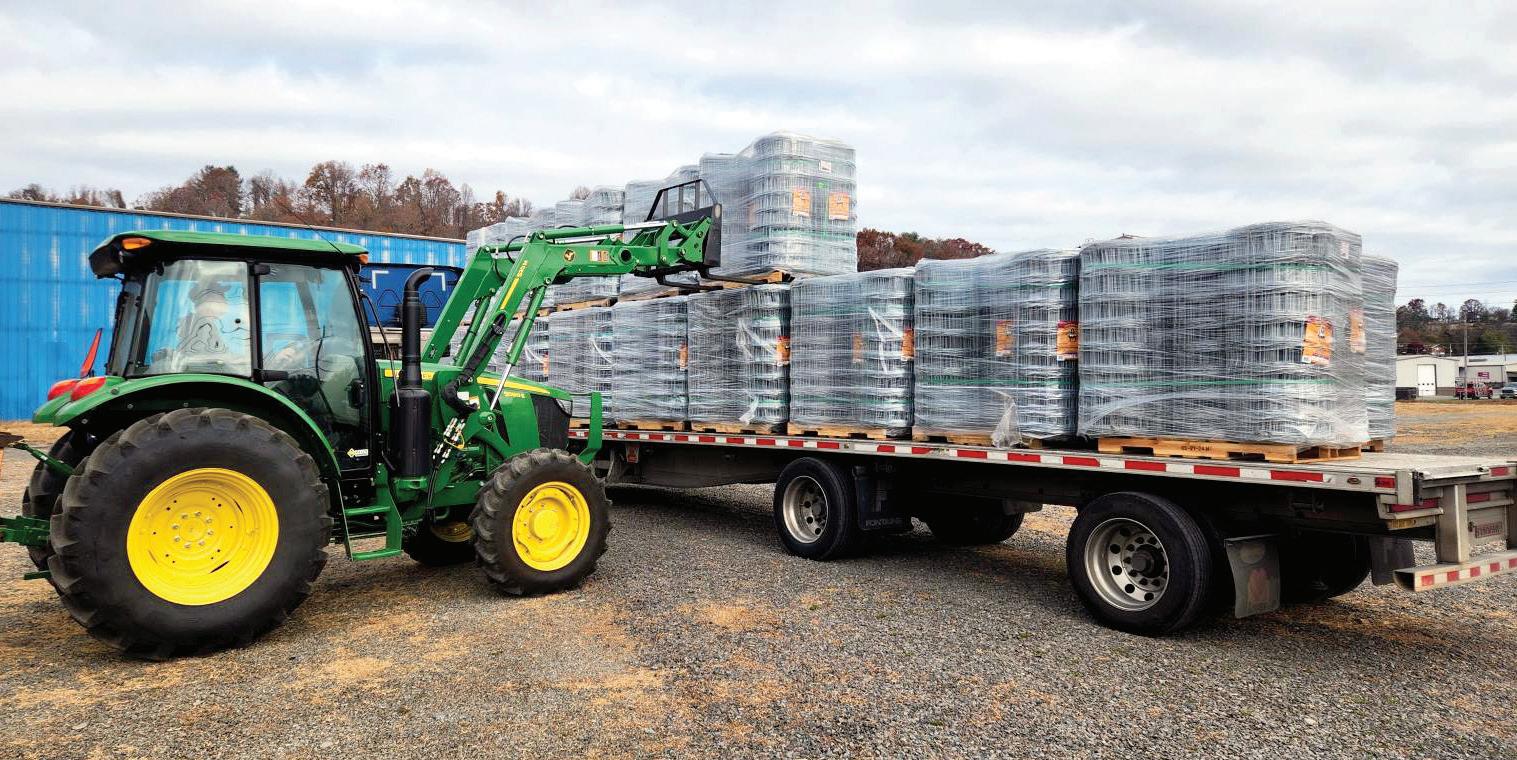
Visit vafairs.com/virginia-farmrelief-fund to learn more about the fund or contribute tax-deductible donations.
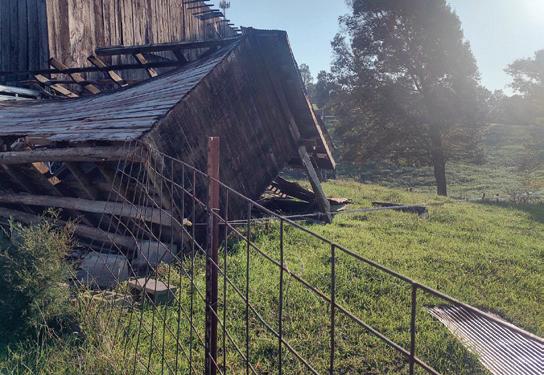
Robbins recalled surveying the damage with her youngest grandchildren, ages 9 and 11.
“The 11-year-old took my hand, and said, ‘Granny, this is just stuff,’” she said. “‘It’s you who we can never replace!’”
The relief fund ballooned with contributions from 69 county Farm Bureaus.
“That’s our culture,” Boyd noted. “Neighbors helping neighbors, even if they’re not next door.”
When the fund went live, Hanover County Farm Bureau was the first to send a check. County president Leigh Pemberton said the board didn’t hesitate to authorize the $2,500 donation.
“Stepping up was simply the right thing to do,” he said. “Farmers look out for farmers. In the agriculture community, we’re all neighbors.”
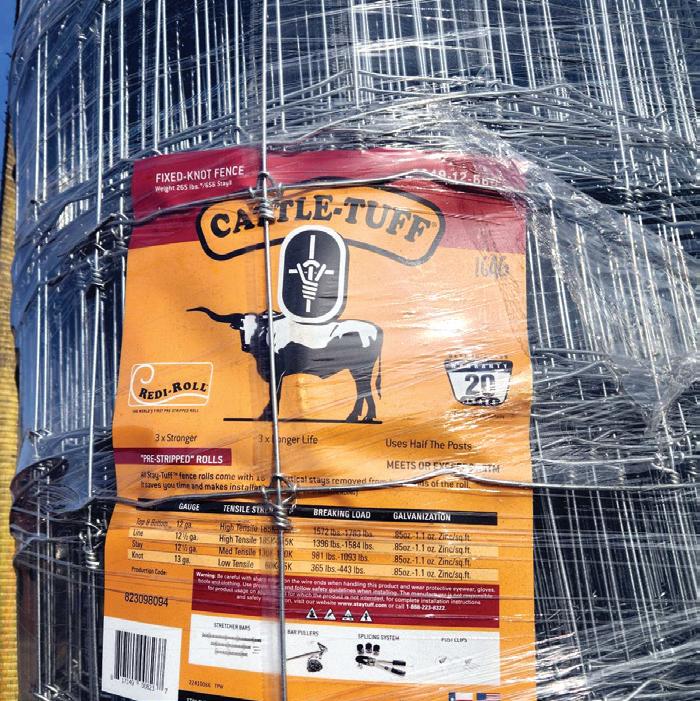
Stoneman said individuals and other state Farm Bureaus also contributed heavily to the fund.
VFBF President Scott Sink expressed gratitude to those who quietly donated money, hay and supplies without waiting on organized efforts.
To sustain the Virginia Farm Relief Fund for future disasters, he is finishing what his predecessor started.
“Hopefully we won’t have to use it again, but we will be prepared if we do,” Sink said. “It needs some refinement, so we are creating a group to evaluate how we handled this situation, how funds were used and implemented, and lessons learned.”


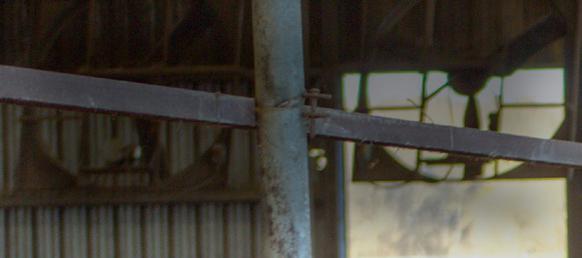





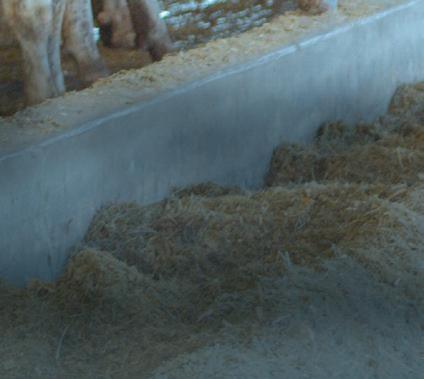

BY CHRISTINA AMANO DOLAN
Nearly a decade ago, a groundbreaking study examined a persisting crisis on family farms—one threatening prosperity and child safety across the industry.
University of Vermont researchers Emily Stengel and Shoshanah Inwood surveyed 186 farm families from various states. A majority echoed challenges with child care availability, affordability and quality, all of which influenced their farm business decisions, families’ wellbeing and farms’ success.
A recent ReadyNation report found the child care crisis’ impact on families, businesses and taxpayers has more than doubled since 2018— costing the U.S. economy an estimated $122 billion a year. ReadyNation is a network of more than 2,000 business executives who promote public policies and programs that build a stronger workforce and economy.
Virginia’s economy loses $3.1 billion annually due to child care challenges, according to the First Five Years Fund, an organization that works to ensure families have affordable access to quality child care and early learning programs for their children.

Surrounded by relatives on their Amelia County dairy farm, Ginny and Brandon Moyer count their blessings as others scramble for child care.
The nearest child care center in their rural community is 20 minutes away. And finding a central place for their infant, toddler and 7-year-old daughter is practically impossible—especially while juggling erratic farming hours.
About 60% of rural residents live in a child care “desert,” according to 2018 data from the Center for American Progress.
The FFYF estimates in Virginia there is a 10% gap in the supply of child care versus potential need.
With Ginny working an off-farm job while Brandon works full time on the farm, they wonder how others manage without family nearby.
“If you don’t have family support nearby and you’re both working on the farm, it would be really hard to afford child care—especially for those just starting out who are having to put a majority of their time and money into their farm,” Ginny said.
In Amelia, paying for center-based child care for an infant, toddler and school-age child would cost over





$23,000 annually, according to the National Database of Childcare Prices. And high rates of provider turnover raise quality concerns. Providers in Virginia earn just $29,490 a year on average, resulting in staffing challenges, the FFYF reports.
Even with ample family help, the Moyers had to get creative.
While Ginny transitioned to remote work, Brandon cut back on his farming hours and hired an extra employee. And with robotic milkers installed, he can now start his workdays after getting the kids ready for school and daycare.
Frederick County farmer Kayla Lawrence transformed her family’s fruit market into a family sanctuary. She incorporated a playground and a play area, complete with farm animals, toys, mini shopping carts and a toy cash register—all inspired by her own needs as a full-time farming parent.
While she’s blessed with family help, bringing her children to work is often necessary. Lawrence’s parents have other responsibilities—resulting in an ever-rotating child care schedule, adjusted work hours and some growing
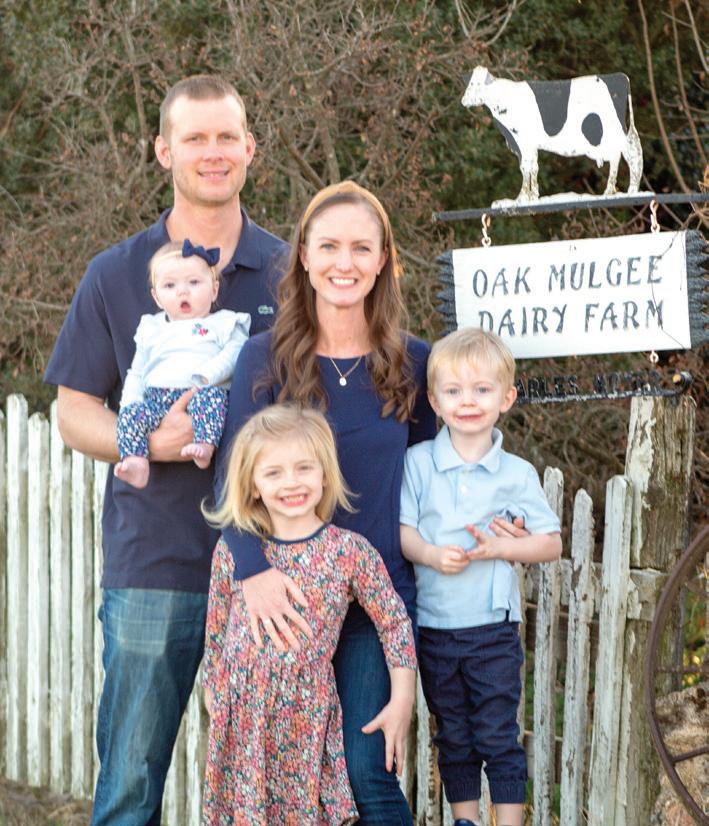

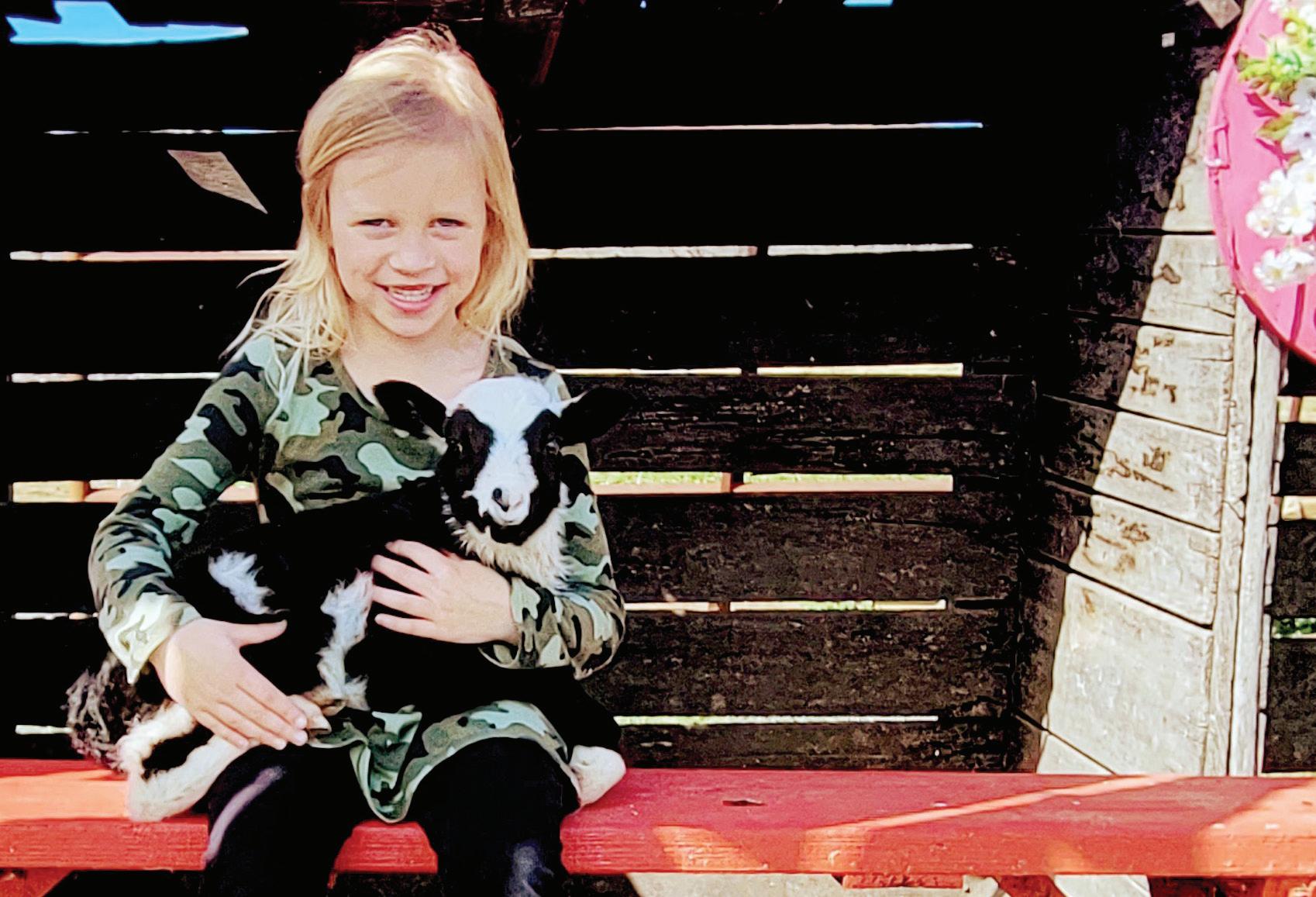

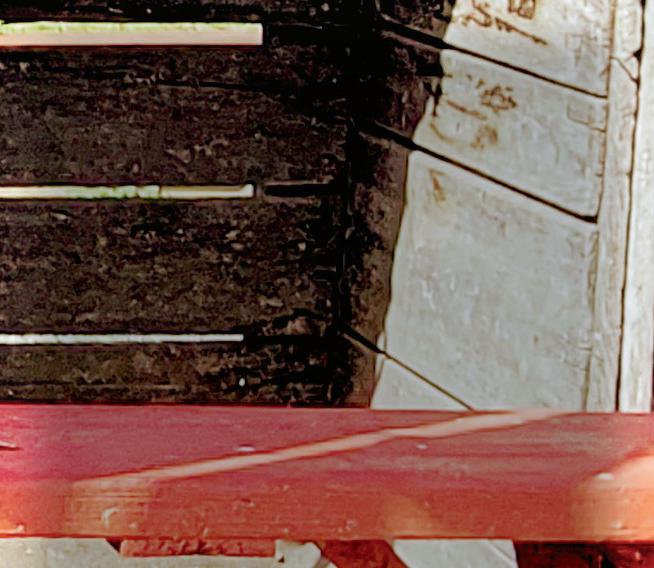
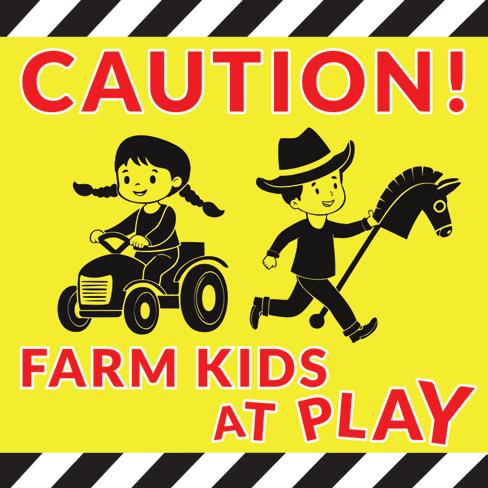

The VFBF Young Farmers Safety subcommittee developed “Farm Kids at Play” signs to be distributed at future Farm Bureau events.
The signs are intended to alert farm visitors to children in the area. Many visitors operate large machinery such as dump trucks, delivery trucks and tractors with limited visibility of their surroundings.
pains at the market.
“In the beginning, it’s extremely difficult because you’re just trying to figure out what’s wrong and what’s right, and how to make your baby comfortable and the customers comfortable,” Lawrence reflected.
But challenges eased as her kids grew older. Her “socialite” 4-year-old often begs to go to the market, and her once-shy 6-year-old has blossomed into a social butterfly through customer interactions.
“Just take it one step at a time,” she encouraged.
The Moyers recommend writing out family goals, assigning household roles and allowing time for vacations.
The Moyer children spend their evenings skipping around their vast outdoor playground—embarking on adventures like scouting for bugs and berries, bottle feeding calves, and saying hello to their grandparents and cousins.
The Moyers keep a close eye on them, as the farm poses many safety risks. As a multigenerational farm family, they know what precautions to take.
“I’d like to see more programming on farm safety for children and parents,” Lawrence remarked.
“I know families who have lost kids to accidents on the farm, and it’s just simple things that firstgeneration farmers may not know.”
Matt Nuckols, chair of the Virginia Farm Bureau Farm Safety Advisory Committee, urges parents to educate children about farm hazards, including safe places to be when farm equipment is around; places on the farm to avoid due to machinery, equipment or chemical hazards; and who to contact if an accident happens.
Virginia Agriculture in the Classroom offers a farm safety activity book for children at Virginia.AgClassroom.org. For a suite of youth farm safety webinars, visit AgriSafe.org.


BY ALICE KEMP
Getting a good night’s rest is easier said than done, especially for farmers.
With their early mornings and late nights, farmers are known for getting the job done no matter how long it takes. When you add in peak season pressures and coping with stressors like unpredictable weather and financial worries, the challenges of maintaining a healthy sleep schedule can be exacerbated.
“Sleep is necessary to restore the body and mind,” said Amy Johnson, family nurse practitioner and Virginia Farm Bureau Farm Safety Advisory Committee member.
While farming is a demanding profession, sleep shouldn’t be considered a luxury. The Sleep Foundation says most adults need at least seven hours of sleep per night to be at their best—yet more than onethird aren’t meeting this benchmark.
The Centers for Disease Control and Prevention report that 39% of adults ages 45 to 64 don’t get enough sleep—the highest percentage among all age groups.
“Lack of sleep can lead to lack of focus and concentration, increasing the risk of injuries due to inattention or falling asleep on the job,” Johnson said. Because it involves working around heavy machinery and unpredictable animals, agriculture is one of the most dangerous occupations—danger that’s amplified when dealing with sleep deprivation. According to a study conducted by the National Institutes of Health and the University of
Nebraska, farmers who sleep less than seven-and-a-half hours per night can increase their risk for injuries by 61%.
“The brain also perceives the lack of sleep as an emergency and elevates the heart rate and blood pressure,” Johnson noted. “Once an individual is sleep deprived for more than 18 hours, the body can respond as if they’ve had a 5% alcoholic drink.”
She added that good sleep is also crucial for a healthy mental state. It allows the brain to “clean and reset itself,” process emotions and maintain cognitive function.
The lack of sleep “can lead to poor problem-solving, decreased coping mechanisms, poor memory and exacerbate underlying anxiety and depression,” Johnson explained. “It can cause people to rely on substances such as stimulants to be more aware and feel more awake.”
Relying on stimulants to stay awake during the day can lead to a vicious cycle.
“People will have trouble sleeping, so they overcompensate during the day with caffeine and then are not able to sleep when they try to go to bed the next night,” she shared.
Some may reach for their phones or tablets or watch TV, but those emit blue light that stimulates the brain, making it even harder to wind down. Tossing and turning in bed, and lying awake frustrated over not being able to sleep can lead to developing anxiety about going to bed. The anxiety, in turn, prevents you from sleeping, which can “soon become a pattern,” Johnson said.
Creating healthy habits around bedtime can help improve sleep. And just like eating well and staying hydrated, “sleep should be a routine that is a regular part of someone’s day,” Johnson emphasized. “Since sleep is so important for overall physical and mental health, it should be a priority.”
Tips for a good night’s sleep:
» Always go to bed and wake up at the same time every day, even on weekends, to regulate the body’s internal clock.
» Have a bedtime routine. This will trigger the brain to know when you’re preparing for bed, and time for sleep.
» Keep your bedroom dark, quiet and at a cool, comfortable temperature. Consider using blackout curtains.
» Invest in quality pillows and bedding to create a comfortable place to sleep.
» Avoid electronics in the bedroom.
» Don’t work, study, watch TV or scroll on your phone while in bed.
» White noise machines, essential oil diffusers and fans can help some fall asleep.
» Avoid caffeine and stimulants late in the day.
» If unable to get enough sleep at night, try taking a 20-30 minute nap during the day to recharge.
» If you’re struggling with sleep issues, consult a healthcare professional for advice and treatment options.
Distracted Driving Awareness Month in April serves as a reminder of the dangers lurking behind the wheel when motorists are distracted.
“It only takes a split second to get distracted and change your life forever,” said Anne Baskette, director of claims administration for Virginia Farm Bureau Mutual Insurance Co. “No call, text or glance away from the road is worth the risk.”

A report by Cambridge Mobile Telematics, the world’s largest telematics service provider, showed a 4.5% decline in distracted driving in 2023, the first decrease since 2020. Experts credited the drop to hands-free laws, usage-based insurance programs and increased media coverage of distracted driving dangers.
Despite the improvement, addressing distracted driving remains a major issue. According to the Virginia Department of Motor Vehicles crash statistics, distracted driving contributed to 17%, or 21,528, of all traffic crashes in 2023. Of those, 11,521 collisions resulted in injuries, and 64 people were killed.
Cellphones continue to be a leading cause of distracted driving. The Insurance Institute for Highway Safety, which has a research center in Greene County, conducted a survey that found half of drivers engaged in at least one devicebased task during most or all drives over the past month.
IIHS also found that crash risk is two to six times greater when drivers manipulate cellphones behind the wheel.
BY ALICE KEMP
Virginia, like many states, adopted a hands-free law that prohibits drivers from handling cellphones while driving. Modern vehicles also offer voice-controlled interfaces to keep drivers’ eyes on the road, but these don’t eliminate distractions entirely. Studies show that drivers still glance away to navigate menus or adjust settings, and issuing voice commands can create cognitive inattention.
John Agee, VFBMIC’s director of casualty claims, said that although cellphones continue to be a major distraction among drivers, “there are many ‘old school’ distractions as well.”
He’s seen claims where drivers were distracted by passenger activity, reaching for items and other disruptions.
“In one accident, the insured’s glasses fell to the floor,” Agee described. “He took his eyes off the road to find the glasses and reached down to get them. When he looked up, he had veered off the road, striking a parked vehicle.”
To continue combating distracted driving, IIHS researchers are promoting a multifaced approach. Along with strengthening hands-free laws and enforcement, leveraging social relationships is key. Discussions among friends and family, and at the workplace, can help make drivers more aware of serious dangers attributed to distracted driving.
Advancements in collision avoidance technology also show promise. Warnings and alerts can refocus a distracted, inattentive or tired driver’s attention back onto the road, while some systems intervene to avoid crashes altogether if a driver doesn’t respond fast enough.
This April, safety advocates are urging motorists to use caution, stay focused and minimize distractions:
• Place cellphones out of reach or use the ‘Do Not Disturb’ feature while driving.
• Set GPS distractions before starting the car.
• Pull over for important tasks.
• Secure loose items so they don’t roll around in the car, causing you to reach for them.
• Avoid multitasking: Don’t eat, apply makeup or adjust controls while in motion.
• Be well-rested: Drowsiness can lead to distractions and delayed reaction times.
• Minimize background distractions by encouraging passengers to respect the driver’s need for concentration.
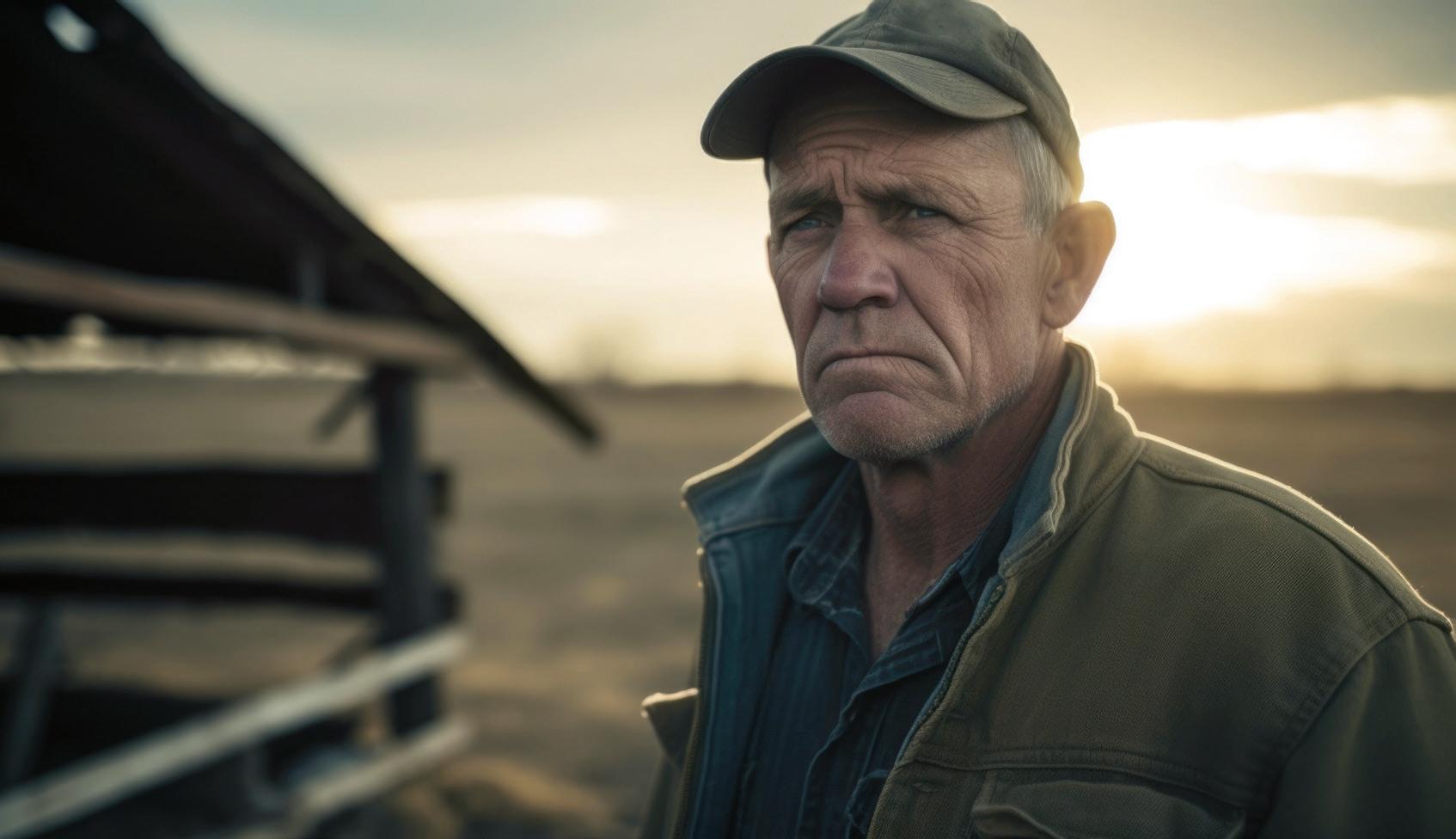
If you or someone you know is struggling or in crisis, help is available. Call or text 988 or chat online at 988lifeline.org




BY ALICE KEMP
Mental health is steadily moving out of the shadows and into mainstream dialogue.
With May designated as Mental Health Awareness Month, it’s an opportunity to recognize mental wellbeing as a critical component of overall health while breaking stigma and sparking conversations.
“More people are being open about their struggles and journeys,” said Tracy Cornatzer, director of sales for VAFB Health Insurance Solutions. “And when more people talk about it, they’re connecting with others, which can lead to finding more help.”
Part of that support comes from expanded insurance benefits. To address the growing need for mental health care, insurers are increasingly broadening coverage to make therapy, counseling, family support services and psychiatric care more accessible than ever.
Although insurance companies are legally required to provide mental health benefits to their insureds, some are going farther. Companies like Anthem Blue Cross and Blue Shield are expanding networks and partnering with more providers. They also are offering convenient options like telehealth, in-home appointments, flexible scheduling, customized treatment plans and reduced waitlists.
“If you’re in rural Virginia, the nearest provider might be many miles away,” shared Howard Dillon, Anthem’s director of strategy programs and sales. “A virtual option is something that gets you care right away—you’re not having to wait and drive.”
And expanding access is more important than ever. The National Alliance on Mental Illness reports that 1 in 5 adults—57.8 million people—experience mental illness each year, and 17% of youth ages 6-17 face a mental health disorder.
“I think the COVID-19 pandemic really brought it to the forefront,” said Steve Jenson, co-founder of Aspire365, a
Your primary care doctor and health insurance company can recommend sources for professional help. To find out more about mental health benefits and coverage options, check with your insurance carrier and mental health care provider.
Additionally, The Virginia Department of Behavioral Health and Development Services’ community services boards also can connect individuals and families with mental health care based on location. Visit bit.ly/3Q9CgJu
comprehensive behavioral health solutions provider and Anthem partner.
He noted that while the pandemic helped normalize mental health discussions, it also intensified the mental health crisis, highlighting the need for accessible, affordable, high-quality care.
“This is really at the next level of getting the right care to the right people at the right time, and in the right setting.”
Recognizing the deep connection between mental and physical health, insurers are embracing a ‘whole health’ approach—integrating medical, prescription drug, dental, vision, life, disability and behavioral benefits.
According to the Centers for Disease Control and Prevention, mental health conditions like depression increase the risk for chronic physical conditions like diabetes, heart disease and stroke. And nearly one in three people with a long-term physical health condition also experiences a mental health issue.
Mental health is no longer an afterthought, Jenson said. Insurers and providers are increasingly adopting integrated approaches.
Aspire365, for example, offers holistic models—addressing mental health alongside physical wellness initiatives like dietary, fitness and lifestyle coaching. Individuals also can complete a preventive behavioral health checkup to assess mental health needs.
“It’s preventive care just like your annual physical or dental checkup,” Jenson said. “The idea is to build mental health into your annual health checkup routine.”
He added that “getting people good mental health care helps them physically. People are realizing that our behavioral health, our mental health, is a key component of overall health. It’s all tied together.”
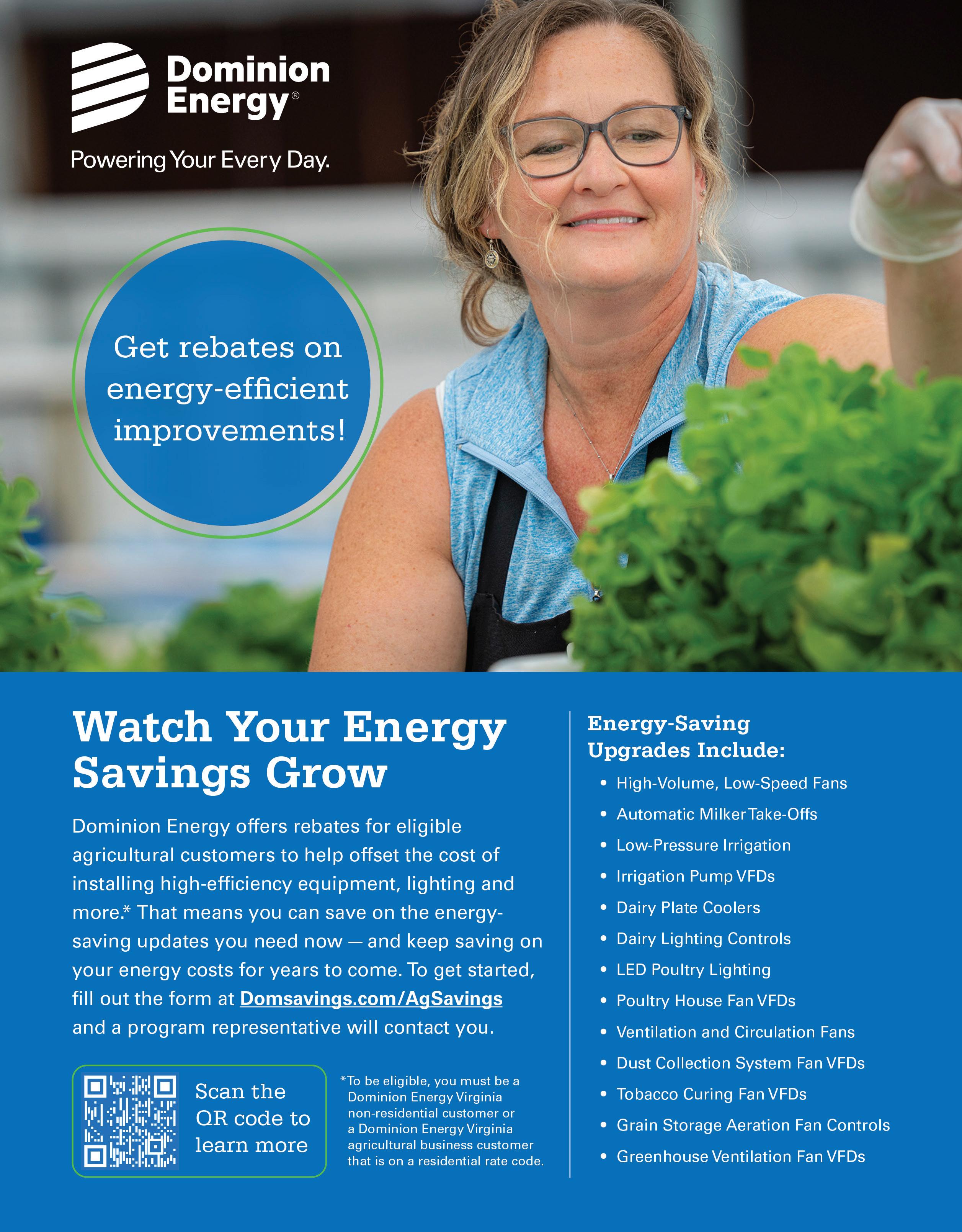

BY ALICE KEMP
As U-pick fields open and tractors pull wagonloads of families on hayrides, farmers are opening their farms but also exposing their operations to potential liability.
Agritourism is more than a trend—it’s a way for producers to connect with their communities while supplementing their income. From pick-your-own berry fields and corn mazes to farm stays and educational tours, more farms across the country are inviting people onto their properties.
Running an agribusiness venture can be a fun and rewarding experience, but it also comes with increased risk for accidents, injuries and property damage.
In addition to ensuring patrons are safe on the farm, farmers should be sure that the farm’s hard-earned assets are protected from liability risks. While standard farmowner policies provide coverage for crop and livestock production and operating roadside stands or farmers markets, they don’t include liability coverage for agritourism.
“Agritourism involves operations that attract patrons to their farm properties, whether it’s for education or entertainment. And an additional insurance coverage endorsement is required for conducting this type of business on the farm,” explained Kim Price, farm and field underwriting manager for Virginia Farm Bureau Mutual Insurance Co.
Agritourism is a broad label, encompassing all kinds of ventures. VFBMIC offers coverage for 74 agritourism


classifications, ranging from smaller activities like home canning to large events like farm festivals.
Policyholders can add an agritourism endorsement any time of year, but farmowners should have the policy in place before the activity season begins. Price explained that the endorsements offer coverage for bodily injury, property damage, products liability and medical expenses for occurrences related to agritourism activities.
“When a farmer considers agritourism events, it’s important to understand that the highest degree of care is required for the safety of visitors coming onto the farm,” she emphasized.
The cost of an agritourism endorsement varies based on the type and size of the operation. The more visitors to the property, the more potential for accidents, so the more expensive the coverage will be.
Having that coverage can provide protection and peace of mind.
“If a farmer is considering an agritourism activity, they should consult with their insurance agent,” Price advised. “The agent will discuss all the events that are being considered so the proper classifications are added to the policy at the appropriate time for providing adequate coverage.”
Price said agents should visit the farm to assess the agritourism activities before providing a quote.









With its rich creaminess and distinctive tangy, earthy flavor, goat cheese has earned its place as a favorite among cheese lovers.
And the global market reflects that enthusiasm. According to Allied Market Research, the goat cheese market was valued at approximately $6 billion in 2022 and is projected to grow to $9.2 billion by 2032. Much of the growing demand is attributed to its health benefits and consumers’ rising interest in artisanal and specialty foods.
Beyond its bold flavor, goat cheese is packed with nutrition. It’s a great source of calcium, probiotics and riboflavin, which supports the body’s growth, development and energy production. It’s also high in selenium, a powerful antioxidant said to boost the immune system and help protect from chronic conditions like heart disease.
Goat cheese comes in a variety of styles— from creamy French chevre and nutty Spanish garrotxa to aged goat gouda and buttery goat brie. Virginia farmers raise 7,668 dairy goats across 753 farms, with many producing fresh, handcrafted cheeses sold at farmers markets, on-farm stores and specialty shops.


4 ounces goat cheese
¾ cup panko breadcrumbs
1 teaspoon dried herbs de Provence
½ teaspoon salt
1 egg, lightly beaten
2 tablespoons vegetable oil, plus more as needed
6 cups mixed greens or lettuce of choice
½ cup sliced strawberries
½ cup thinly sliced cucumbers
¼ cup thinly sliced shallots
⅓ cup salad dressing of choice
Slice the goat cheese into rounds, either four large or up to six small. Shape the rounds into medallions, and set aside.
Using a mixing bowl, add the panko, herbs de Provence and salt, and mix until combined. Place the beaten egg in a separate bowl.
Dip a goat cheese medallion in the beaten egg, and coat completely. Then transfer to the bowl of seasoned breadcrumbs, tossing until fully coated. Place on a plate, and repeat with remaining medallions. Place the plate in the freezer, and chill for 10 minutes.
Meanwhile, in a large bowl, toss together the greens, strawberries, cucumber and shallots. Keep refrigerated until ready to serve.
Place a nonstick skillet over medium heat, and add the vegetable oil. When the oil is hot, add the goat cheese medallions, and cook for about 2 minutes per side, or until all sides are golden and crispy. Add more oil to the pan if needed during cooking to prevent sticking.
Place the medallions on paper towels to drain and cool slightly. Lightly season with salt if desired.
Toss salad with salad dressing and divide among four plates. Top each salad with goat cheese medallions.
—Recipe adapted from the California Strawberry Commission

4 ounces cranberry goat cheese, room temperature
1 tablespoon minced fresh rosemary
2 cloves garlic, minced
3-4-pound boneless leg of lamb, butterflied avocado oil
salt and pepper
Heat oven to 425°.
In a small bowl, combine the goat cheese, rosemary and garlic, and mash together until well blended.
Lay the butterflied lamb flat on a cutting board, and season generously with salt and pepper. Spread the goat cheese mixture on one side of the butterflied lamb, then pick up the other side and close it over top. Tie the lamb together using 3-4 pieces of cooking twine so it’s secured well.
Drizzle the surface of the lamb with avocado oil, and season the outside with salt and pepper.
Drizzle a tablespoon of avocado oil in a 12” cast iron skillet over high heat. Once hot, place the lamb in the skillet, and brown on both sides, about 4 minutes per side.
Once browned, transfer the skillet to the preheated oven, and cook for about 15-18 minutes for medium-rare or until internal temperature reaches 145°.
Remove from the oven, cover, and rest for 10-15 minutes before slicing and serving.
—Recipe courtesy of the American Lamb Board, Running to the Kitchen
Tip: To butterfly the leg of lamb yourself, first trim any excess fat on the outside of the lamb, then open up your roast, laying it flat on a cutting board. Starting at the thickest part of the meat, slice horizontally through the lamb, leaving the end intact so the meat opens up like a book and there is even thickness.

3 tablespoons unsalted butter
½ tablespoon honey
2-3 sprigs fresh thyme
1 medium red onion, sliced pinch fine sea salt
pinch ground black pepper
1 sheet frozen puff pastry (from a 17-ounce box), thawed ⅓ cup strawberry jam
2½ ounces chèvre (fresh goat cheese), crumbled warm honey for serving thyme leaves for garnish
DIRECTIONS
Heat the oven to 350°.
In a medium skillet, melt the butter over medium-high heat. Stir in the honey and sprigs of thyme. Add the onion, stirring often, and cook for 3-4 minutes until the onion softens. Remove the onion from the heat, and add the pinch of salt and pepper.
Unfold the sheet of puff pastry onto a cutting board, and cut into six rectangles. Transfer to a baking sheet.
Spread an equal amount of jam over each square of pastry, and top with the crumbled goat cheese. Remove the sprigs of thyme from the onion, and divide the cooked onion slices over each of the tarts.
Bake for 25 minutes until the tarts are browned and baked through. Serve warm, drizzle with warm honey, and sprinkle with fresh thyme leaves.
—Recipe adapted from the National Onion Association






Virginia Farm Bureau Health Insurance Solutions® is offering free, online Medicare seminars with information about eligibility, enrollment periods. and plan options.
April 17 — 10 a.m. July 15 — 10 a.m.
May 20 — 6 p.m. August 21 — 6 p.m.
June 4 — 2 p.m. September 10 — 10 a.m.
RSVP to your county Farm Bureau, or register online at vafb.com/health/medicare-seminars












Bruce L. Hiatt, a Cana orchardist and former president of the Virginia Farm Bureau Federation, died March 8 at the age of 84.
Mr. Hiatt was elected VFBF president in 1998 and served in that capacity until 2006. The apple and cherry grower had previously served as vice president since 1988 and had been on the VFBF board since 1981.
Past VFBF President Wayne Pryor was a board member when Mr. Hiatt was vice president, and then when he was elected president, Pryor served under him as vice president.
“Over those 17 years of serving with him, Bruce was very dedicated to Farm Bureau, and while I was vice president, he gave me many opportunities to get involved,” Pryor remembered.
When elected president, Mr. Hiatt described Farm Bureau as an organization he had “admired, respected and loved” since the early 1980s when he first became involved.
“I feel very strongly about the grassroots concept of Farm Bureau, and I am a strong believer in our county Farm Bureau organization,” he said at the time.
Pryor said Mr. Hiatt also strongly believed in the influence of American Farm Bureau Federation’s lobbying efforts. AFBF had offices in both Chicago and Washington, but Mr. Hiatt was “a big proponent of American Farm Bureau closing its Chicago office and consolidating with the Washington office, since that’s where
the politics are. It was the right move, and I think one of his biggest accomplishments,” Pryor shared.
Mr. Hiatt also was devoted to promoting the value of a Farm Bureau membership. He increased the number of VFBF agricultural lobbyists; transitioned the newspaper Virginia Farm Bureau News into a color magazine; and grew the Virginia Agriculture in the Classroom program and the Women’s and Young Farmers programs. During his tenure, membership rose to more than 148,000 households.
Current VFBF President Scott Sink said Mr. Hiatt had just been elected president when he got involved with the Young Farmers Program. “His support of them encouraged me to increase my involvement and pursue future leadership opportunities within Farm Bureau, leading me to where I am today,” Sink noted.
VFBF Director of Field Services
Dennis Jones worked side by side with Mr. Hiatt when he served on the Carroll County Farm Bureau board before moving into his statewide role.
“Bruce was a great guy with a good sense of humor who could be serious when he needed to be,” Jones shared. “He was very devoted to Farm Bureau.”
Former corporate secretary Jonathan Shouse, who served under Mr. Hiatt during his presidency, agreed.
“When addressing an audience, he spoke with the authority of the
president but always spoke softly, and with humor, making everyone feel welcomed and important,” Shouse recalled. “If something did need to change … things would change.”
Under Mr. Hiatt’s leadership, Farm Bureau created its political action committee, the VFBF AgPAC. He also worked to persuade the General Assembly to create a secretary of agriculture and forestry cabinet position, which heightened awareness of those industries.
In 1999, Mr. Hiatt was elected to the American Farm Bureau Federation board of directors. He also served on the board of directors for Blue Cross Blue Shield of Southwestern Virginia and Southern Farm Bureau Life Insurance Co.
Like many Farm Bureau leaders, Mr. Hiatt hadn’t planned a career in Farm Bureau. Rather, a friend asked him to serve on the county Farm Bureau board in 1979. A few years later, a fellow volunteer asked him to run for a seat on the state board of directors. That led to over 30 years of involvement with the farm organization.
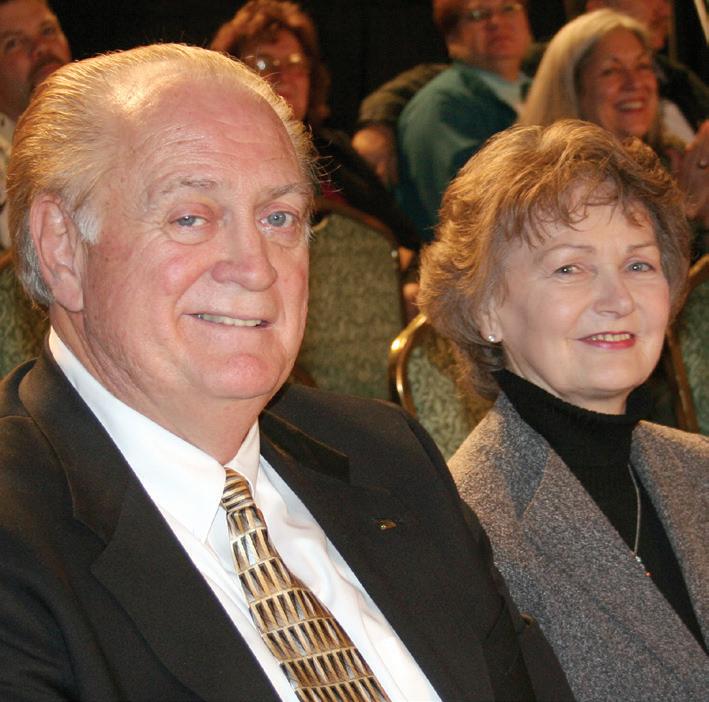
With a background in farming, law enforcement and the military, and as a claims manager for U.S. Fidelity & Guarantee Co., he had the experience to lead Farm Bureau into the 21st century.
Mr. Hiatt is survived by his wife, Connie; a daughter, son-in-law and granddaughter; a sister; and others.
